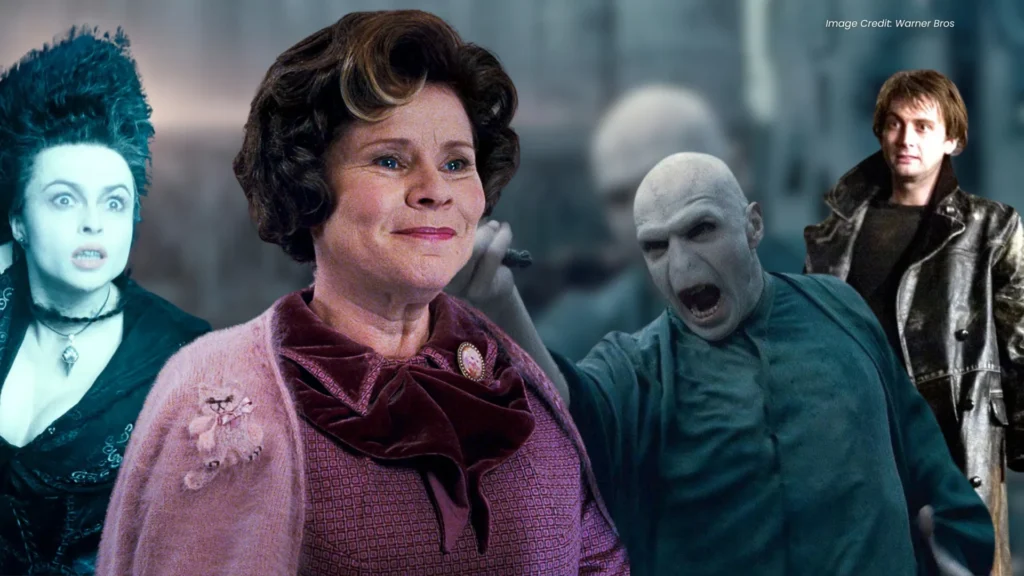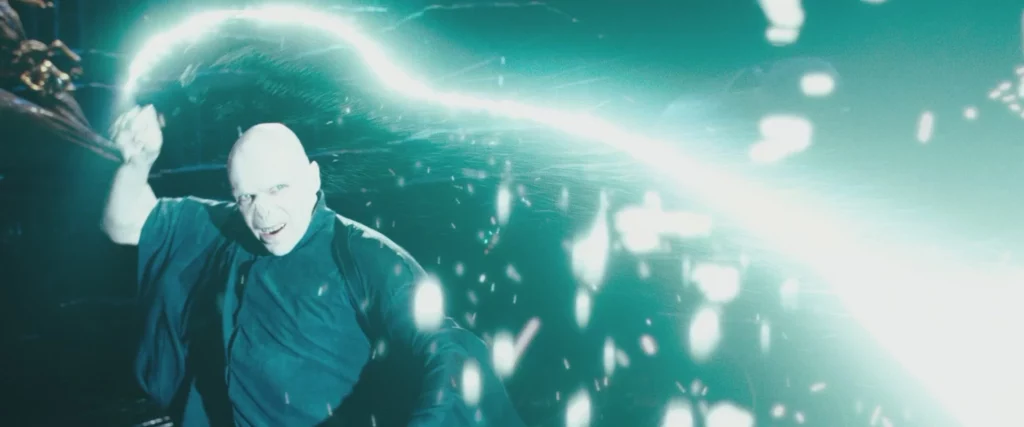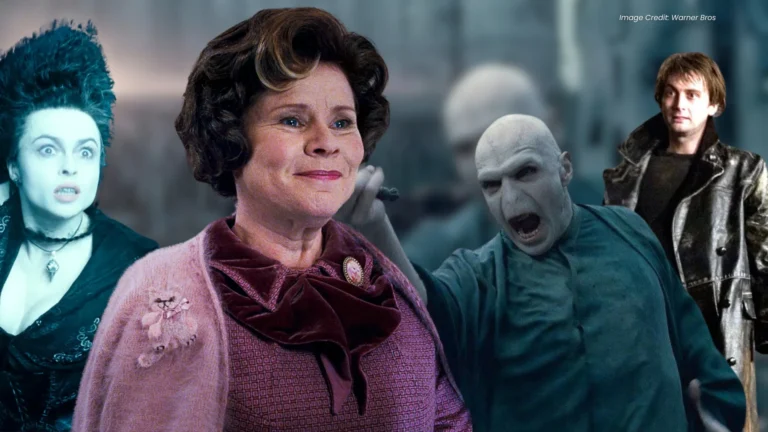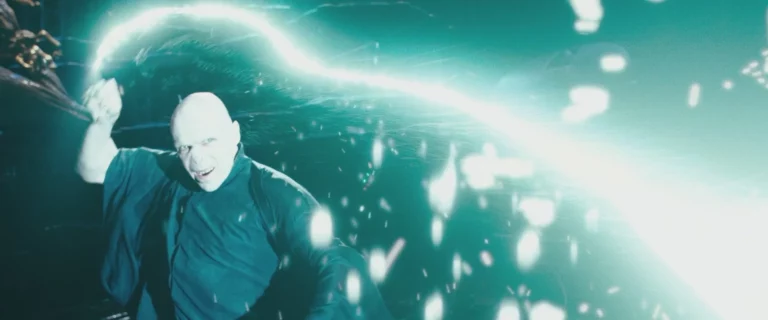Have you ever wondered about the incredible spells used by Harry Potter and his friends? From casting light with a simple “Lumos” to conjuring a protective Patronus with “Expecto Patronum,” the magical spells in J.K. Rowling’s Wizarding World are as fascinating as they are diverse. Whether you’re a seasoned fan who has read all the books and watched the movies countless times, or a newcomer just beginning your journey into the magical world, understanding these spells can deepen your appreciation for the series.
In this guide, we’ll explore the wide array of Harry Potter spells, charms, hexes, curses, and jinxes that make the Harry Potter universe so enchanting. You’ll learn about the basics of spellcasting, discover the different types of magic, and get an in-depth look at some of the most iconic spells from the series. Plus, we’ll share a fun fact about how you can use the spells “Lumos” and “Nox” to control your iPhone’s flashlight through Siri. So grab your wand, and let’s dive into the magical world of Harry Potter spells!
Magic in Harry Potter
The Harry Potter universe is a wondrous realm where magic is an intrinsic part of daily life. At its core, magic is about harnessing supernatural powers to produce remarkable effects, whether for mundane tasks or epic battles against dark forces. Here, we’ll explore the basics of magic, including how it works and the different types you’ll encounter in the Wizarding World.
Basics of Magic
In the Harry Potter series, magic is typically wielded through a combination of spoken incantations and wand movements. These two elements are crucial for casting spells successfully:
- Incantations: The verbal component of a spell. Wizards and witches must pronounce these words clearly to invoke the desired magical effect. Most incantations are derived from Latin, giving them an ancient and mystical quality.
- Wand Movements: The physical gestures made with a wand to direct and shape the magical energy. Each spell has a specific movement associated with it, which can range from a simple flick to a complex series of motions.
While young witches and wizards initially rely heavily on both incantations and wand movements, skilled practitioners can perform non-verbal magic, where the spell is cast without speaking, and even wandless magic, though this is rare and requires immense talent and concentration.
Types of Magic
Magic in the Harry Potter universe is diverse and multifaceted, encompassing various types of spells that serve different purposes. Here are the main categories:
- Charms
- Definition: Charms are spells that add certain properties to an object or individual without changing its inherent nature.
- Examples: “Lumos” to produce light from the wand tip, and “Accio” to summon objects.
- Curses
- Definition: Curses are dark spells intended to cause harm or exert control over another person.
- Examples: The Unforgivable Curses like “Avada Kedavra” for killing, “Crucio” for causing unbearable pain, and “Imperio” for mind control.
- Hexes
- Definition: Hexes are spells that inflict moderate harm or misfortune on the target.
- Examples: “Langlock” which glues the target’s tongue to the roof of their mouth, and “Rictusempra” which causes uncontrollable laughter.
- Jinxes
- Definition: Jinxes are minor dark spells that cause inconvenience or annoyance.
- Examples: “Flipendo” which knocks objects backward, and “Slugulus Eructo” which makes the victim vomit slugs.
- Enchantment
- Definition: Enchantments are spells that imbue an object with magical properties that often last over time.
- Examples: The “Unbreakable Vow” which, if broken, results in death, and “Fidelius Charm” which hides a secret within a person’s soul.
The Art of Spellcasting
Mastering magic requires dedication and practice. Here are some essential tips for aspiring witches and wizards:
- Clear Pronunciation: Ensuring incantations are spoken clearly is vital for spell effectiveness.
- Precision in Wand Movements: Even slight deviations in wand movements can alter the outcome of a spell.
- Focus and Intent: Strong mental focus and a clear intent behind the spell significantly improve the chances of success.
Understanding these basics and the different types of magic sets the foundation for delving deeper into the fascinating spells and their uses within the Harry Potter universe. Whether you’re just starting your magical education or looking to refine your spellcasting skills, this guide will help you navigate the enchanting world of wizardry.
Essentials of Spellcasting
To truly understand the magic of the Harry Potter universe, it’s essential to grasp the basics of spellcasting. This process, while often portrayed with a certain flair and drama in the films and books, is governed by some fundamental principles that every witch or wizard must master. Here’s a breakdown of the key elements involved in casting spells effectively.
Incantations
Definition: The spoken words or phrases that activate a spell.
Importance: Proper pronunciation is crucial. Mispronouncing an incantation can lead to unintended consequences or the spell failing entirely.
Example: “Wingardium Leviosa” – It’s crucial to enunciate “Levi-o-sa” correctly, as Hermione Granger famously demonstrated.
Wand Movements
Definition: The specific gestures made with a wand to direct and shape magical energy.
Importance: Precision is key. Even a slight mistake in the movement can alter the spell’s effect.
Example: The swish and flick movement required for the Levitation Charm.
Focus and Intent
Definition: The mental state and clarity of purpose a wizard or witch maintains while casting a spell.
Importance: Magic in the Harry Potter universe is heavily influenced by the caster’s focus and intent. A distracted or uncertain caster is less likely to succeed.
Example: Casting the Patronus Charm (“Expecto Patronum”) requires the caster to focus on their happiest memory.
Emotion and Willpower
- Definition: The emotional energy and willpower behind a spell.
- Importance: Strong emotions can enhance a spell’s power. Conversely, negative emotions or lack of willpower can weaken it.
- Example: Harry Potter’s strong desire to protect himself from Dementors helps him produce a powerful Patronus.
Harry Potter Spell List (Alphabetically)
The magical world of Harry Potter is filled with an extensive array of spells, charms, hexes, curses, and jinxes. Here, we provide a comprehensive alphabetical list of spells featured across the books, movies, video games, and other media. Each spell includes its type, effect, notable uses, and a brief contextual paragraph to help you understand their significance in the Wizarding World.
Table of Contents
A
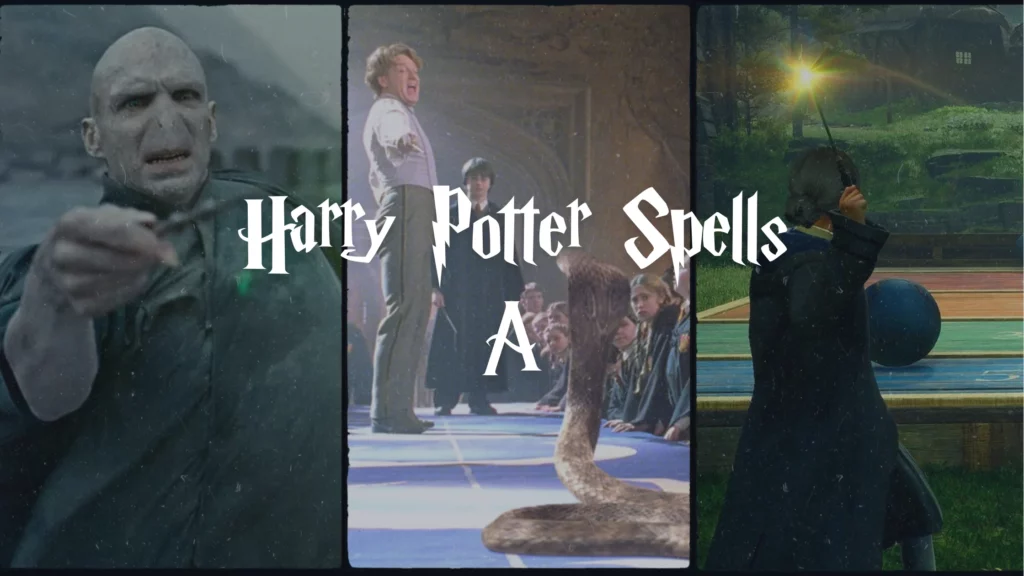
Aberto
- Type: Charm
- Effect: Opens objects
- Notable Uses: Seen in “Fantastic Beasts and Where to Find Them.”
Aberto is a simple charm that is particularly useful for unlocking doors or other objects. It’s especially handy for those moments when you need quick access to something that is securely closed. Newt Scamander uses this spell in the “Fantastic Beasts” series, demonstrating its practical application in magical exploration.
Accio
Pronunciation: AK-ee-oh / AH-see-oh
- Type: Charm
- Effect: Summons an object
- Notable Uses: Frequently used by Harry Potter to retrieve his broomstick.
Accio, also known as the summoning charm, summons an object to the caster. The word ‘accio’ is Latin for ‘summon’. This is a very useful spell for retrieving items that are out of reach and it’s often used for convenience to bring objects closer without having to physically move to retrieve them. The only things that cannot be summoned are living creatures and large items like buildings. A key moment when this spell is used is in “Harry Potter and the Goblet of Fire,” when Harry summons his broom during the first task of the Triwizard Tournament.
Age Line
- Type: Enchantment
- Effect: Hides things from younger people
- Notable Uses: Used by Dumbledore to prevent underage students from entering the Triwizard Tournament.
The Age Line is an advanced form of enchantment that creates a boundary only passable by those of a certain age. It was famously used by Albus Dumbledore during the Triwizard Tournament to prevent students under the age of seventeen from entering their names into the Goblet of Fire, illustrating the spell’s effectiveness in maintaining rules and safety.
Aguamenti
Pronunciation: AH-gwah-MEN-tee
- Type: Charm
- Effect: Shoots water from the wand
- Notable Uses: Used by Harry Potter to extinguish fire during the Horcrux hunt.
Aguamenti is a charm that produces a jet of water from the caster’s wand. This spell is particularly useful in situations where water is needed but not readily available. In “Harry Potter and the Half-Blood Prince,” Harry uses Aguamenti to douse Hagrid’s hut fire, showing its practical applications in emergencies.
Alarte Ascendare
- Type: Spell
- Effect: Shoots things high in the air
- Notable Uses: Used by Gilderoy Lockhart in “Harry Potter and the Chamber of Secrets.”
Alarte Ascendare is a spell that propels objects into the air. Gilderoy Lockhart uses this spell to attempt to showcase his magical prowess, but as usual, it doesn’t go quite as planned. The spell highlights Lockhart’s tendency to overestimate his abilities, providing a humorous moment in the series.
Alohomora
- Type: Charm
- Effect: Opens locked objects
- Notable Uses: Frequently used by Hermione Granger to unlock doors.
If there’s a pesky locked door that needs opening, then we recommend the Unlocking Charm. It proved to be useful when Harry, Ron, and Hermione needed to make a quick escape from Filch. Unfortunately, that particular door led to a giant three-headed dog… but when faced with an irate caretaker or Fluffy, we’d rather face the latter. Alohomora is one of the first spells Hermione masters, showcasing her knack for problem-solving and quick thinking.
Anapneo
- Type: Spell
- Effect: Clears the target’s airway
- Notable Uses: Used by Professor Slughorn to save Marcus Belby.
Anapneo is a lifesaving spell that clears a person’s airway, allowing them to breathe freely. This spell is particularly crucial in medical emergencies, as demonstrated when Professor Slughorn uses it to save Marcus Belby from choking during a dinner party in “Harry Potter and the Half-Blood Prince.”
Anteoculatia
- Type: Hex
- Effect: Turns head hair into antlers
- Notable Uses: Mentioned in “Fantastic Beasts.”
Anteoculatia is a mischievous hex that causes the victim’s hair to transform into antlers. This spell showcases the playful yet troublesome side of magic, often used more for pranks than practical purposes. It’s a reminder of the light-hearted and sometimes whimsical nature of the magical world.
Anti-Cheating
- Type: Spell
- Effect: Prevents cheating on exams
- Notable Uses: Used during O.W.L. exams at Hogwarts.
The Anti-Cheating spell is employed during important exams like the O.W.L.s at Hogwarts to ensure fairness. By preventing students from cheating, this spell maintains the integrity of magical education and ensures that all students are assessed on their true abilities.
Aparecium
- Type: Spell
- Effect: Reveals invisible ink
- Notable Uses: Used by Hermione Granger to read hidden messages.
Aparecium is the perfect spell for revealing hidden messages written in invisible ink. Hermione Granger uses this spell in her quest for knowledge and truth, illustrating its utility in uncovering secrets and solving mysteries. This spell highlights the theme of discovery and the pursuit of knowledge that runs throughout the series.
Apparate
- Type: Spell
- Effect: Teleportation spell
- Notable Uses: Widely used by wizards and witches for instant travel.
Apparition is a magical form of teleportation, allowing the caster to disappear from one location and reappear in another almost instantly. This advanced spell requires a licence to perform legally due to the risk of “splinching,” where parts of the body can be left behind if the spell is improperly executed. It’s a crucial skill for adult witches and wizards, providing quick escape routes and efficient travel.
Appare Vestigium
- Type: Spell
- Effect: Shows traces of recently used spells in the area
- Notable Uses: Used by Newt Scamander in “Fantastic Beasts: The Crimes of Grindelwald.”
Appare Vestigium reveals the magical traces left by recent spellwork. This investigative spell is particularly useful for Aurors and magical law enforcement officers in tracking down criminal activities or piecing together the sequence of events at a magical crime scene. Newt Scamander uses it to uncover hidden traces of magic in Paris.
Arania Exumai
- Type: Spell
- Effect: Blasts away spiders
- Notable Uses: Used by Harry Potter in the Chamber of Secrets.
Arania Exumai is specifically designed to repel spiders and other arachnids. Harry Potter uses this spell to defend himself against the Acromantula in the Forbidden Forest. This spell exemplifies the practical and sometimes very specific applications of magic in the wizarding world.
Aqua Eructo
- Type: Spell
- Effect: Shoots water from the wand
- Notable Uses: Seen in various video games.
Aqua Eructo is similar to Aguamenti, producing a stream of water from the caster’s wand. This spell is versatile for extinguishing fires, hydrating plants, or even providing a drink in the absence of a water source. It’s one of many utility spells that show the everyday practicalities of magic.
Arresto Momentum
- Type: Spell
- Effect: Slows down objects
- Notable Uses: Used by Dumbledore to save Harry from falling.
Arresto Momentum is a spell that decreases the speed of a moving object, effectively slowing it down or stopping it entirely. Professor Dumbledore uses this spell in “Harry Potter and the Prisoner of Azkaban” to save Harry from a fall. This spell highlights the importance of quick thinking and reflexes in dangerous situations.
Ascendio
- Type: Spell
- Effect: Moves an object upward
- Notable Uses: Used by Harry Potter to propel himself out of the lake during the Triwizard Tournament.
- Ascendio propels the caster or the targeted object upwards, overcoming the forces of gravity. Harry Potter uses this spell during the second task of the Triwizard Tournament to rapidly ascend from the depths of the Black Lake. This spell demonstrates how magic can assist in physical feats that would otherwise be impossible.
Avada Kedavra
Pronunciation: ah-VAH-dah keh-DAH-vrah
- Type: Curse
- Effect: Causes instant death
- Notable Uses: Used by Voldemort and his followers.
Avada Kedavra, one of the Unforgivable Curses, causes instant death to its victim and is recognizable by the flash of green light that accompanies it. This dark spell is feared throughout the wizarding world and is used by Voldemort and his Death Eaters to commit numerous murders. Its use is strictly prohibited and punishable by life imprisonment in Azkaban.
Avenseguim
- Type: Curse
- Effect: Tracking spell
- Notable Uses: Used in “Fantastic Beasts.”
Avenseguim is a tracking spell used to follow the movements of a specific target. This spell is particularly useful for locating individuals or objects that have been hidden or are on the move. It’s another example of how magic can aid in surveillance and investigation.
Avifors
- Type: Charm
- Effect: Turns small objects into birds
- Notable Uses: Seen in various video games.
Avifors transforms small objects into birds, showcasing the transformative abilities of magic. This spell can be used both for practical purposes and as a display of magical prowess. It highlights the whimsical and creative side of spellcasting.
Avis
- Type: Spell
- Effect: Launches birds from your wand
- Notable Uses: Used by Hermione Granger during the battle at the Department of Mysteries.
Avis conjures a flock of birds from the caster’s wand, which can be used for distraction, signalling, or simply as a demonstration of magical skill. Hermione Granger uses this spell during the battle at the Department of Mysteries to create a diversion, showing its utility in combat situations.
B
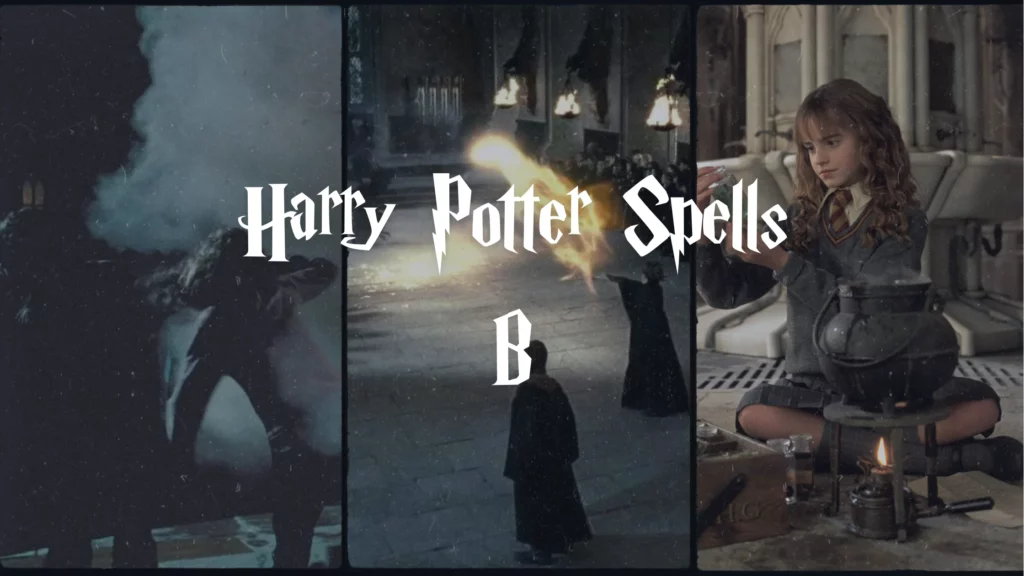
Babbling Curse
- Type: Curse
- Effect: Makes a person babble
- Notable Uses: Mentioned in various contexts throughout the series.
The Babbling Curse causes the victim to speak incoherently, making it impossible for them to communicate effectively. This spell is often used to disorient and confuse opponents, rendering them unable to cast spells or provide coherent information.
Baubillious
- Type: Spell
- Effect: Damages opponent or creatures
- Notable Uses: Seen in the Trading Card Game.
Baubillious is a damaging spell that can be used against opponents or creatures. It showcases the offensive capabilities of magic in duelling and combat situations. This spell is part of the broader category of battle spells that witches and wizards use for defence and attack.
Bluebell Flames
- Type: Spell
- Effect: Shoots blue flames at the opponent
- Notable Uses: Used by Hermione Granger to create portable fire.
Bluebell Flames conjures a blue, magical fire that can be contained in a jar or used directly. Hermione Granger uses this spell to create portable, controlled fire for warmth and light. The flames are known for their intensity and magical properties, such as not burning the container they are in.
Bombarda
- Type: Spell
- Effect: Causes explosions
- Notable Uses: Used by Dolores Umbridge to blast open the Room of Requirement.
Bombarda is an explosive spell used to cause controlled explosions, making it effective for breaking through obstacles or barriers. Dolores Umbridge uses this spell to force entry into the Room of Requirement in “Harry Potter and the Order of the Phoenix,” demonstrating its destructive power.
Bombarda Maxima
- Type: Spell
- Effect: Causes large explosions
- Notable Uses: Used by Hermione Granger to break into Bellatrix Lestrange’s vault.
Bombarda Maxima is a more powerful version of the Bombarda spell, creating significantly larger explosions. Hermione Granger uses this spell to breach the security of Bellatrix Lestrange’s vault in “Harry Potter and the Deathly Hallows,” highlighting its use in high-stakes situations.
Bubble-Head Charm
- Type: Charm
- Effect: Puts a person’s head in a protective air bubble
- Notable Uses: Used by students at Hogwarts to breathe underwater during the Triwizard Tournament.
The Bubble-Head Charm creates a bubble of air around the caster’s head, allowing them to breathe in environments where air is not available, such as underwater. It’s particularly useful for extended underwater activities, as seen during the Triwizard Tournament’s second task.
C
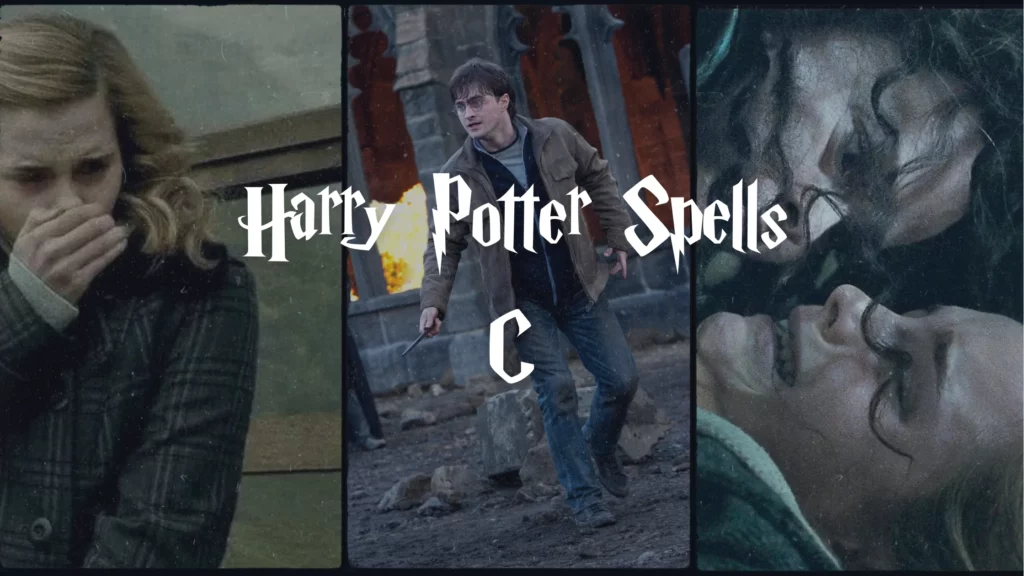
Calvario
- Type: Spell
- Effect: Causes hair loss
- Notable Uses: Seen in the Lego Harry Potter video games.
Calvario is a spell that causes the victim’s hair to fall out. This spell is often used for humorous or vengeful purposes, highlighting the more lighthearted and mischievous uses of magic.
Cantis
- Type: Spell
- Effect: Forces a person to sing
- Notable Uses: Seen in the Lego Harry Potter video games.
Cantis compels the target to sing uncontrollably. This spell can be used to embarrass or distract the victim, adding a whimsical element to magical duels and pranks.
Carpe Retractum
- Type: Spell
- Effect: Shoots a rope from the wand to snag things
- Notable Uses: Seen in various video games.
Carpe Retractum is a spell that conjures a rope of light from the caster’s wand, which can be used to grab and pull objects or even individuals. It’s particularly useful for retrieving items that are out of reach or pulling oneself across gaps.
Cascading Jinx
- Type: Jinx
- Effect: Damages opponents
- Notable Uses: Seen in various video games.
The Cascading Jinx is an offensive spell that causes damage to the target. It is used in duelling scenarios and provides an example of the jinxes used to incapacitate or harm opponents in combat situations.
Caterwauling Charm
- Type: Charm
- Effect: Detects enemies and emits a scream
- Notable Uses: Used to protect Hogsmeade in “Harry Potter and the Deathly Hallows.”
The Caterwauling Charm is a protective spell that emits a loud, piercing shriek when someone crosses its boundary. It is used to alert the caster to intrusions and is particularly useful for security purposes. This charm is employed in “Harry Potter and the Deathly Hallows” to protect the village of Hogsmeade from intruders.
Cave Inimicum
- Type: Charm
- Effect: Detects enemies and emits an alarm
- Notable Uses: Used by Hermione Granger during the trio’s camping trips in “Harry Potter and the Deathly Hallows.”
Cave Inimicum is a defensive spell used to create a protective boundary around the caster. This spell alerts the caster to the presence of enemies and is used to secure locations against intruders.
Cheering Charm
- Type: Charm
- Effect: Makes a person happy and giddy
- Notable Uses: Taught at Hogwarts School of Witchcraft and Wizardry.
The Cheering Charm is used to induce a sense of joy and happiness in the target. This charm is often used to lift spirits and can be particularly effective in alleviating stress or sadness. It is taught to students at Hogwarts, emphasising its role in everyday magical life.
Cistem Aperio
- Type: Spell
- Effect: Opens things
- Notable Uses: Used by Tom Riddle in “Harry Potter and the Chamber of Secrets.”
Cistem Aperio is a spell that opens sealed containers or objects. Tom Riddle uses this spell to open the Chamber of Secrets in “Harry Potter and the Chamber of Secrets.” It highlights the practical uses of magic in accessing hidden or secured items.
Colloportus
- Type: Spell
- Effect: Locks doors
- Notable Uses: Used by Hermione Granger in “Harry Potter and the Order of the Phoenix.”
Colloportus is a spell that magically locks doors, preventing entry. Hermione Granger uses this spell to secure doors against intruders in “Harry Potter and the Order of the Phoenix.” It demonstrates the defensive capabilities of magic in securing spaces.
Colloshoo
- Type: Spell
- Effect: Makes a person’s shoes stick to the ground
- Notable Uses: Seen in various video games.
Colloshoo causes the target’s shoes to adhere to the ground, immobilising them. This spell is typically used in duelling and prank scenarios, showcasing the more mischievous side of spellcasting.
Colovaria
- Type: Charm
- Effect: Changes the colour of an object
- Notable Uses: Taught at Hogwarts School of Witchcraft and Wizardry.
Colovaria is a charm that changes the colour of an object. This spell is often used for decorative purposes and in Transfiguration classes at Hogwarts, demonstrating the versatility and creative potential of magic.
Confringo
- Type: Curse
- Effect: Causes explosions
- Notable Uses: Used by Harry Potter to destroy the locket Horcrux.
Confringo is a powerful curse that causes objects to explode. Harry Potter uses this spell to destroy the locket Horcrux in “Harry Potter and the Deathly Hallows.” It illustrates the destructive capabilities of magic when used in combat or for destroying dark objects.
Confundus
- Type: Charm
- Effect: Used to confuse opponents
- Notable Uses: Used by Hermione Granger to manipulate Cormac McLaggen during Quidditch trials.
Confundus is a charm that causes confusion in the target, making them easily manipulated or disoriented. Hermione Granger uses this spell on Cormac McLaggen to ensure Ron Weasley is chosen as the Gryffindor Keeper in “Harry Potter and the Half-Blood Prince.
Conjunctivitis
- Type: Curse
- Effect: Damages opponents’ eyesight
- Notable Uses: Used by Viktor Krum during the Triwizard Tournament.
Conjunctivitis is a curse that affects the target’s eyes, causing pain and impaired vision. Viktor Krum uses this spell on the Chinese Fireball dragon during the Triwizard Tournament to gain an advantage in the first task.
Cornflake Skin
- Type: Curse
- Effect: Gives a person cereal-like skin
- Notable Uses: Mentioned in the series.
Cornflake Skin is a humorous curse that causes the victim’s skin to resemble cornflakes. This spell is an example of the whimsical and sometimes ridiculous nature of certain magical curses.
Crucio
- Type: Curse
- Effect: Causes unbearable pain
- Notable Uses: Used by Death Eaters to torture their victims.
Crucio, one of the Unforgivable Curses, inflicts excruciating pain on the victim. It is commonly used by Death Eaters to torture their enemies and extract information. Its use is strictly forbidden and punishable by life imprisonment in Azkaban.
Cushioning Charm
- Type: Charm
- Effect: Helps cushion a fall
- Notable Uses: Used on broomsticks to make them more comfortable.
The Cushioning Charm creates an invisible cushion over surfaces, making them soft and safe to land on. It is often used on broomsticks to make riding more comfortable and safer, highlighting the everyday practical applications of magic.
D
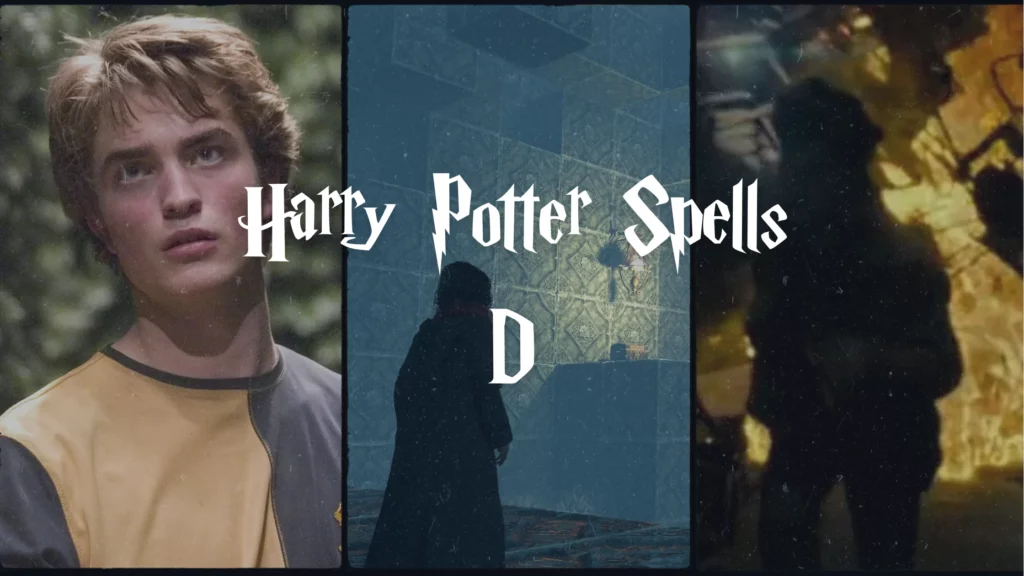
Defodio
- Type: Spell
- Effect: Digs out materials
- Notable Uses: Used by Hermione Granger to create an escape route from Gringotts.
Defodio is a spell that digs out or carves through materials such as rock or metal. Hermione Granger uses this spell to help create an escape route from Gringotts in “Harry Potter and the Deathly Hallows.” It demonstrates the utility of magic in physical tasks and escape situations.
Deletrius
- Type: Spell
- Effect: Counters “Prior Incantato”
- Notable Uses: Used by Amos Diggory to remove the image of the Dark Mark.
Deletrius is a spell used to erase the effects of the “Prior Incantato” spell, which reveals the last spell cast by a wand. Amos Diggory uses it to remove the image of the Dark Mark from Harry’s wand in “Harry Potter and the Goblet of Fire.”
Densaugeo
- Type: Spell
- Effect: Enlarges teeth
- Notable Uses: Used by Draco Malfoy on Hermione Granger.
Densaugeo is a spell that causes the target’s teeth to enlarge rapidly. Draco Malfoy uses this spell on Hermione Granger in “Harry Potter and the Goblet of Fire,” resulting in her front teeth growing uncontrollably until corrected by Madam Pomfrey.
Deprimo
- Type: Spell
- Effect: Wind-damaging spell
- Notable Uses: Used by Hermione Granger to escape from the Death Eaters at Xenophilius Lovegood’s house.
Deprimo is a powerful spell that creates a strong downward blast of wind, causing significant damage to the target area. Hermione Granger uses this spell to escape from the Death Eaters at Xenophilius Lovegood’s house in “Harry Potter and the Deathly Hallows.”
Depulso
- Type: Charm
- Effect: Drives an object away
- Notable Uses: Used to repel objects and opponents.
Depulso is a charm used to repel objects or individuals away from the caster. It is often used in duelling and defensive situations to create distance between the caster and potential threats.
Descendo
- Type: Spell
- Effect: Moves an object downwards
- Notable Uses: Used by Ron Weasley to lower a chandelier in “Harry Potter and the Deathly Hallows.”
Descendo is a spell that moves objects downward, often used to lower items safely. Ron Weasley uses this spell to drop a chandelier on the Death Eaters at Malfoy Manor, providing a distraction that allows the trio to escape.
Diffindo
- Type: Spell
- Effect: Splits seams
- Notable Uses: Used by Harry Potter to cut Cedric Diggory free from the roots during the Triwizard Tournament.
Diffindo is a spell that severs or splits objects cleanly apart. Harry Potter uses this spell during the Triwizard Tournament to free Cedric Diggory from the roots that have trapped him. This spell demonstrates its utility in precise cutting and separating tasks.
Diminuendo
- Type: Spell
- Effect: Shrinks the target
- Notable Uses: Seen in various video games.
Diminuendo is a spell that causes the target to shrink in size. This spell is useful for reducing the size of objects or creatures and showcases the transformative powers of magic.
Dissendium
- Type: Spell
- Effect: Opens passageways
- Notable Uses: Used by Harry Potter to access the secret passage to Honeydukes.
Dissendium is a spell used to open hidden or secret passageways. Harry Potter uses this spell to access the secret passage leading to Honeydukes in Hogsmeade, highlighting its application in exploration and secretive travel.
Disillusionment Charm
- Type: Charm
- Effect: Makes the target blend into the surroundings
- Notable Uses: Used by Mad-Eye Moody on Harry Potter in “Harry Potter and the Order of the Phoenix.”
The Disillusionment Charm camouflages the target, making them blend into their surroundings like a chameleon. Mad-Eye Moody uses this charm on Harry Potter to help him avoid detection by Muggles while travelling.
Duro
- Type: Spell
- Effect: Makes objects hard
- Notable Uses: Used by Hermione Granger during the Battle of Hogwarts.
Duro is a spell that hardens objects, turning them into stone or a similarly hard substance. Hermione Granger uses this spell during the Battle of Hogwarts to create barriers and obstacles for Death Eaters.
Draconifors
- Type: Spell
- Effect: Turns the target into a dragon
- Notable Uses: Seen in various video games.
Draconifors transforms small objects into dragons. This spell is often used in duelling and combat scenarios in video games, demonstrating the imaginative and powerful transformations possible with magic.
Drought Charm
- Type: Charm
- Effect: Dries up puddles
- Notable Uses: Taught at Hogwarts School of Witchcraft and Wizardry.
The Drought Charm removes water from surfaces, effectively drying them. This charm is useful for clearing puddles and other unwanted moisture, showcasing the practical applications of magic in daily life.
Ducklifors
- Type: Spell
- Effect: Turns things into ducks
- Notable Uses: Seen in various video games.
Ducklifors transform the target into a duck. This spell is another example of the whimsical and humorous side of magic, often used for pranks and light-hearted transformations.
E
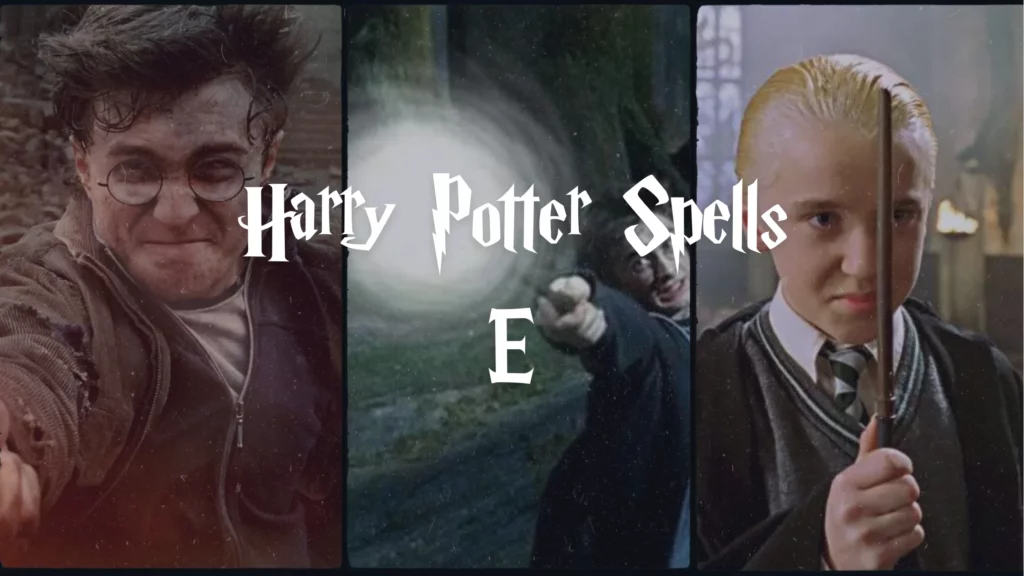
Ears to Kumquats
- Type: Spell
- Effect: Gives a person kumquat ears
- Notable Uses: Mentioned in the series.
Ears to Kumquats is a humorous spell that transforms the victim’s ears into kumquats. This spell illustrates the playful and sometimes absurd nature of certain magical transformations.
Ear Shriveling Curse
- Type: Curse
- Effect: Causes a person’s ears to shrivel
- Notable Uses: Mentioned in the series.
The Ear Shriveling Curse causes the target’s ears to shrivel up, rendering them useless. This spell is often used for punishment or in duelling scenarios to disorient and incapacitate the victim.
Ebublio
- Type: Jinx
- Effect: Puts an object in a large bubble
- Notable Uses: Seen in various video games.
Ebublio traps the target in a large bubble, preventing them from escaping or moving freely. This jinx is useful for containment and immobilisation in combat or prank situations.
Engorgio
- Type: Charm
- Effect: Enlarges an item
- Notable Uses: Used by Ron Weasley to enlarge a spider in “Harry Potter and the Goblet of Fire.”
Engorgio is a charm that causes the target to swell in size. Ron Weasley uses this spell to enlarge a spider in “Harry Potter and the Goblet of Fire,” showcasing its ability to alter the size of objects and creatures dramatically.
Engorgio Skullus
- Type: Hex
- Effect: Engorges a skull
- Notable Uses: Seen in various video games.
Engorgio Skullus is a hex that specifically targets the victim’s skull, causing it to swell. This spell is often used for intimidation or incapacitation in duelling scenarios.
Ennervate
- Type: Spell
- Effect: Counters “Stupefy”
- Notable Uses: Used to revive stunned individuals.
Ennervate is a spell that revives individuals who have been stunned by the “Stupefy” spell. This spell is essential in duelling and combat situations for quickly bringing allies back into action.
Entomorphis
- Type: Hex
- Effect: Makes the target an insect
- Notable Uses: Seen in various video games.
Entomorphis transforms the target into an insect. This hex is used for incapacitation and transformation in duelling scenarios, highlighting the more transformative aspects of hexes.
Entrail-Expelling Curse
- Type: Curse
- Effect: Expels entrails from a body
- Notable Uses: Mentioned in the series.
The Entrail-Expelling Curse is a gruesome curse that forces the victim’s entrails out of their body. This dark spell is used for torture and severe punishment, demonstrating the lethal capabilities of curses.
Episkey
- Type: Spell
- Effect: Heals minor injuries
- Notable Uses: Used by Nymphadora Tonks to heal Harry Potter’s broken nose.
Episkey is a healing spell used to mend minor injuries such as cuts and bruises. Nymphadora Tonks uses this spell to heal Harry Potter’s broken nose in “Harry Potter and the Half-Blood Prince,” showcasing its practical application in medical emergencies.
Epoximise
- Type: Spell
- Effect: Binds objects together
- Notable Uses: Mentioned in the series.
Epoximise is a spell that binds objects together, similar to a magical adhesive. This spell is useful for repairs and construction, demonstrating the everyday utility of magic.
Erecto
- Type: Spell
- Effect: Builds things
- Notable Uses: Used by Hermione Granger to set up a tent.
Erecto is a spell used to construct and arrange objects. Hermione Granger uses this spell to quickly set up a tent during their camping trips in “Harry Potter and the Deathly Hallows,” highlighting its usefulness in assembling structures.
Evanesce
- Type: Spell
- Effect: Makes things disappear
- Notable Uses: Seen in various trading card games.
Evanesce is a spell that causes objects to vanish. This spell is used to clean up or remove unwanted items, showcasing the practical applications of magic in maintaining order and cleanliness.
Evanesco
- Type: Spell
- Effect: Makes things vanish
- Notable Uses: Used by Professor Snape to vanish the potion in “Harry Potter and the Half-Blood Prince.”
Evanesco is a spell that causes objects to disappear completely. Professor Snape uses this spell to vanish potion ingredients and cauldrons during Potions class, demonstrating its utility in cleaning up and removing unwanted items.
Everte Statum
- Type: Spell
- Effect: Throws a victim backwards
- Notable Uses: Used by Draco Malfoy in “Harry Potter and the Chamber of Secrets.”
Everte Statum is a spell that sends the target flying backwards. Draco Malfoy uses this spell during a duelling club session against Harry Potter in “Harry Potter and the Chamber of Secrets,” showcasing its effectiveness in combat situations.
Expecto Patronum
- Type: Charm
- Effect: Creates a Patronus – A defensive guardian
- Notable Uses: Used by Harry Potter to ward off Dementors.
Expecto Patronum is a powerful defensive charm that conjures a Patronus, a magical guardian that protects against Dementors. Harry Potter uses this spell to save Sirius Black and himself from a swarm of Dementors in “Harry Potter and the Prisoner of Azkaban.”
Expelliarmus
- Type: Charm
- Effect: Disarms your opponent
- Notable Uses: Harry Potter’s signature spell.
Expelliarmus is a disarming charm that forces whatever an opponent is holding to fly out of their hands. This spell is Harry Potter’s signature move, often used to disarm opponents without causing them serious harm, reflecting his preference for non-lethal combat.
Expulso
- Type: Spell
- Effect: Makes objects explode
- Notable Uses: Used by Antonin Dolohov in “Harry Potter and the Deathly Hallows.”
Expulso causes objects to explode with great force. Antonin Dolohov uses this spell in “Harry Potter and the Deathly Hallows” to attack Harry and his friends, demonstrating its destructive capabilities in combat.
Extinguishing Spell
- Type: Spell
- Effect: Puts out fires
- Notable Uses: Seen in various video games.
The Extinguishing Spell is used to put out fires. This spell is essential for controlling and eliminating flames in emergency situations, showcasing its practical applications in fire safety.
F
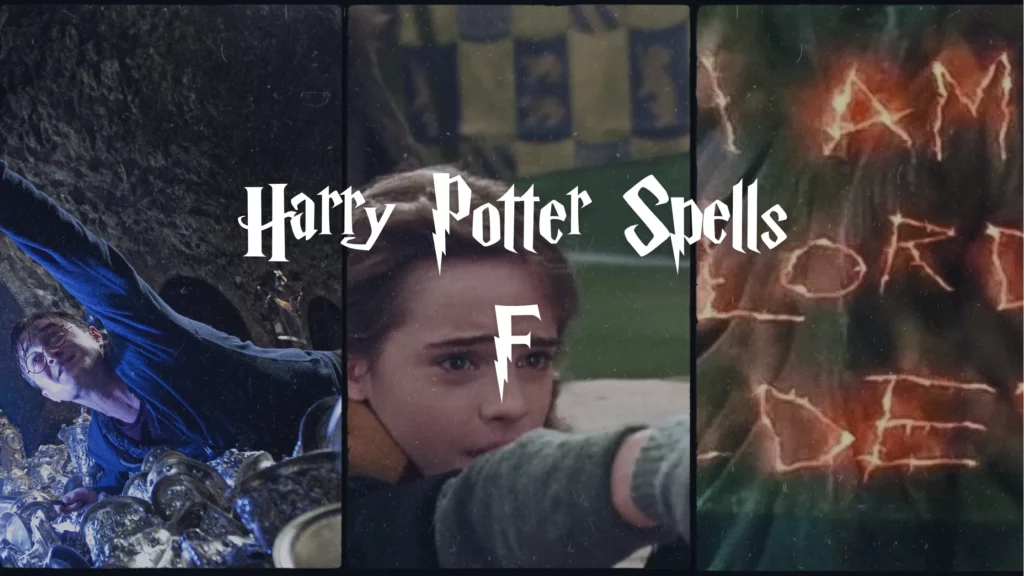
Ferula
- Type: Spell
- Effect: Creates bandages
- Notable Uses: Used by Remus Lupin to bandage Ron Weasley’s leg in “Harry Potter and the Prisoner of Azkaban.”
Ferula is a healing spell that conjures bandages to wrap wounds. Remus Lupin uses this spell to bandage Ron Weasley’s leg after an encounter with Sirius Black, highlighting its utility in medical emergencies.
Fianto Duri
- Type: Charm
- Effect: Defensive charm
- Notable Uses: Used to strengthen protective enchantments.
Fianto Duri is a defensive charm used to strengthen existing protective enchantments. This spell enhances the durability and effectiveness of barriers, making them more resistant to attack.
Fidelius Charm
- Type: Charm
- Effect: Hides a secret within someone
- Notable Uses: Used to hide the Potters’ location.
The Fidelius Charm is an advanced spell that conceals a secret within the soul of a designated Secret Keeper. This spell was used to hide the location of James and Lily Potter from Voldemort, illustrating its powerful protective properties.
Fiendfyre
- Type: Curse
- Effect: Difficult to control, large fire curse – Dark Magic
- Notable Uses: Used by Vincent Crabbe in “Harry Potter and the Deathly Hallows.”
Fiendfyre is a dangerous and highly destructive fire curse that produces enchanted flames capable of destroying nearly anything in their path. Vincent Crabbe uses this curse in the Room of Requirement, leading to disastrous consequences.
Finestra
- Type: Spell
- Effect: Turns windows to dust
- Notable Uses: Used by Hermione Granger to escape from the Lovegood house.
Finestra is a spell that shatters glass and turns it into dust. Hermione Granger uses this spell to escape from the Lovegood house by creating an exit through a window, demonstrating its practical application in urgent situations.
Finite
- Type: Spell
- Effect: Finishes spells in the caster’s area
- Notable Uses: Used by Professor Snape to end spells.
Finite is a spell that cancels out other ongoing spells in the area. Professor Snape uses this spell to stop various magical effects during his time as a teacher at Hogwarts, showcasing its importance in controlling and ending magical phenomena.
Finite Incantatem
- Type: Spell
- Effect: Stops any current spells
- Notable Uses: Used by Hermione Granger to stop a rogue spell.
Finite Incantatem is a more powerful version of Finite, capable of ending multiple spells simultaneously. Hermione Granger uses this spell to counter various charms and curses, highlighting its utility in managing and controlling magic.
Flagrante Curse
- Type: Curse
- Effect: Multiplies and burns objects upon touch
- Notable Uses: Used in the Lestrange vault at Gringotts.
The Flagrante Curse causes objects to become extremely hot and burn anyone who touches them. This curse is used in the Lestrange vault at Gringotts to protect valuable items by making them dangerous to handle.
Flagrate
- Type: Spell
- Effect: Allows the user to write on objects
- Notable Uses: Used by Hermione Granger to mark doors in the Department of Mysteries.
Flagrate is a spell that creates fiery marks or lines on objects. Hermione Granger uses this spell to mark doors in the Department of Mysteries to navigate the confusing hallways, demonstrating its use in leaving messages or symbols.
Flame-Freezing Charm
- Type: Charm
- Effect: Makes flames cool
- Notable Uses: Used by witches and wizards accused of witchcraft to avoid harm.
The Flame-Freezing Charm makes fire harmless to those it touches, turning flames into a cool sensation. This charm was historically used by witches and wizards accused of witchcraft to survive being burned at the stake.
Flipendo
- Type: Jinx
- Effect: Knocks an object backwards
- Notable Uses: Commonly used in various video games.
Flipendo is a jinx that causes the target to be knocked backward. This spell is frequently used in video games for its ability to move objects and opponents, making it a staple in magical duelling.
Flipendo Duo
- Type: Jinx
- Effect: More powerful version of Flipendo
- Notable Uses: Seen in various video games.
Flipendo Duo is a more powerful variant of the Flipendo jinx, offering greater force and effect. It is often used in advanced duelling and combat situations in video games.
Flipendo Tria
- Type: Jinx
- Effect: Even stronger than Flipendo Duo
- Notable Uses: Seen in various video games.
Flipendo Tria is the most powerful version of the Flipendo jinx, capable of delivering significant force. This spell is used in high-stakes combat scenarios in video games, showcasing its offensive capabilities.
Flying Charm
- Type: Charm
- Effect: Makes objects fly
- Notable Uses: Used to enchant broomsticks.
The Flying Charm is used to make objects, such as broomsticks, capable of flight. This charm is essential for Quidditch and other magical transportation, illustrating its importance in the wizarding world.
Fumos
- Type: Spell
- Effect: Creates a defensive cloud of smoke
- Notable Uses: Used to create cover during battles.
Fumos conjures a thick cloud of smoke, providing cover and obscuring visibility. This spell is particularly useful in duelling and combat situations to create confusion and protect the caster from attacks.
Furnunculus
- Type: Curse
- Effect: Produces boils on the opponent
- Notable Uses: Used by Harry Potter on Draco Malfoy.
Furnunculus causes painful boils to erupt on the victim’s skin. Harry Potter uses this curse on Draco Malfoy during a confrontation, showcasing its use in causing physical discomfort and disfigurement.
G
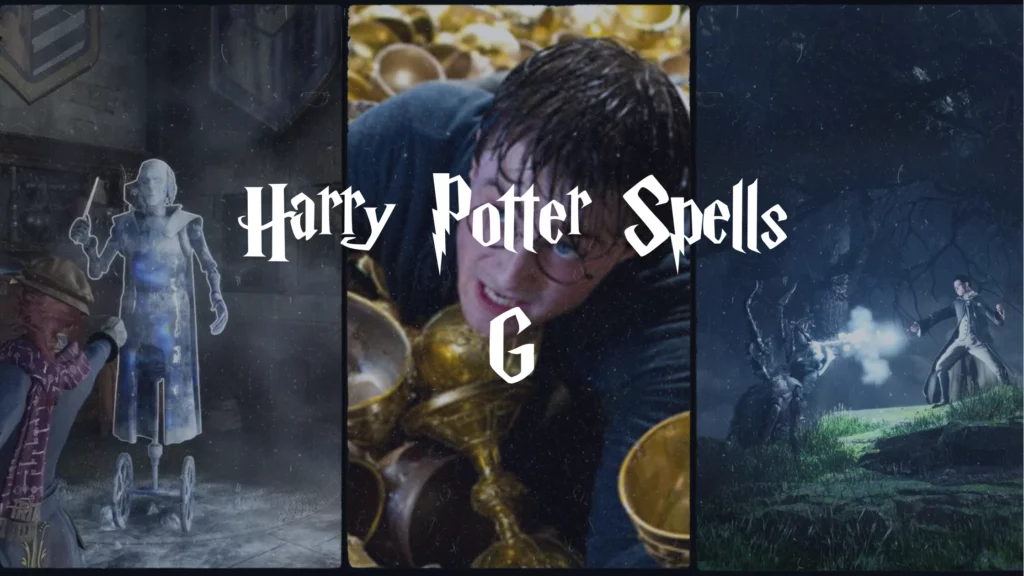
Geminio
- Type: Spell
- Effect: Duplicates an object
- Notable Uses: Used in the Lestrange vault at Gringotts.
Geminio is a spell that duplicates objects, creating an identical copy. This spell is used in the Lestrange vault at Gringotts to create duplicate treasures, making it difficult to distinguish the original from the copies.
Glacius
- Type: Spell
- Effect: Freezes objects
- Notable Uses: Seen in various video games.
Glacius is a freezing spell that encases the target in ice. This spell is useful for immobilising opponents and creating icy barriers, highlighting its versatility in combat and defensive situations.
Glacius Tria
- Type: Spell
- Effect: More powerful version of Glacius
- Notable Uses: Seen in various video games.
Glacius Tria is a more powerful variant of the Glacius spell, capable of freezing larger objects or stronger opponents. This enhanced spell is often used in advanced magical combat scenarios.
Glisseo
- Type: Spell
- Effect: Turns stairs into ramps
- Notable Uses: Used by Hermione Granger in “Harry Potter and the Deathly Hallows.”
Glisseo transforms stairs into smooth ramps, making it easier to slide down. Hermione Granger uses this spell to facilitate a quick escape during their time at Hogwarts, demonstrating its practical applications in urgent situations.
Gripping Charm
- Type: Charm
- Effect: Makes it easier to hold things
- Notable Uses: Used on broomsticks and other objects.
The Gripping Charm enhances the ability to hold onto objects securely. This charm is commonly used on broomsticks to improve the rider’s grip and control, highlighting its importance in magical sports and activities.
H
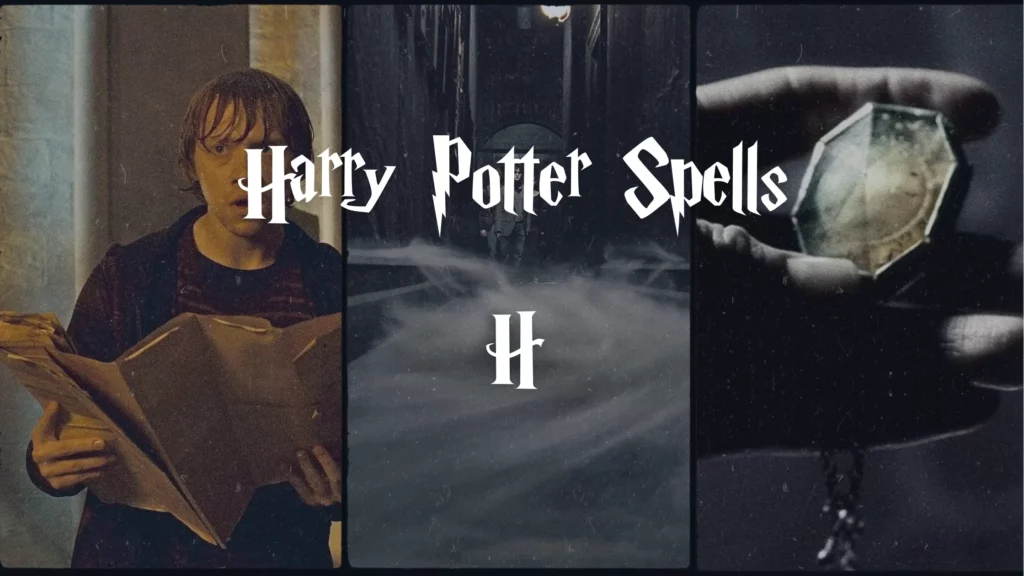
Harmonia Nectere Passus
- Type: Spell
- Effect: Mends broken things
- Notable Uses: Used to repair the Vanishing Cabinet.
Harmonia Nectere Passus is a spell used to repair and mend broken objects. This spell is notably used to fix the Vanishing Cabinet, allowing Death Eaters to infiltrate Hogwarts in “Harry Potter and the Half-Blood Prince.”
Herbifors
- Type: Spell
- Effect: Makes a person grow flowers
- Notable Uses: Seen in various video games.
Herbifors is a spell that causes flowers to sprout from the target’s body. This whimsical spell is often used for decorative purposes and highlights the creative and playful side of magic.
Herbivicus
- Type: Charm
- Effect: Makes plants grow faster
- Notable Uses: Seen in various video games.
Herbivicus accelerates the growth of plants, making them flourish rapidly. This charm is particularly useful in gardening and Herbology, showcasing its practical applications in nurturing plant life.
Homenum Revelio
- Type: Spell
- Effect: Reveals humans nearby
- Notable Uses: Used by Hermione Granger to detect people in “Harry Potter and the Deathly Hallows.”
Homenum Revelio detects the presence of nearby humans, making it useful for locating hidden individuals. Hermione Granger uses this spell to ensure their safety while hiding from Death Eaters, demonstrating its importance in security and surveillance.
Homonculous Charm
- Type: Charm
- Effect: Allows a person to track others’ movements on a map
- Notable Uses: Basis for the Marauder’s Map.
The Homonculous Charm enables the tracking of individuals’ movements on a map. This charm is the basis for the creation of the Marauder’s Map, allowing the user to see the real-time locations of everyone at Hogwarts.
Homorphus Charm
- Type: Charm
- Effect: Lockhart’s werewolf “cure”
- Notable Uses: Claimed to be used by Gilderoy Lockhart.
The Homorphus Charm is a spell that supposedly cures werewolves by turning them back into humans. Gilderoy Lockhart claims to have used this charm, though its effectiveness is dubious given his propensity for exaggeration and dishonesty.
Horcrux Curse
- Type: Curse
- Effect: Allows a wizard to put their soul into an object
- Notable Uses: Used by Voldemort to create Horcruxes.
The Horcrux Curse enables a wizard to split their soul and hide a part of it in an object, effectively achieving a form of immortality. Voldemort uses this dark and forbidden magic to create multiple Horcruxes, making him extraordinarily difficult to kill.
I
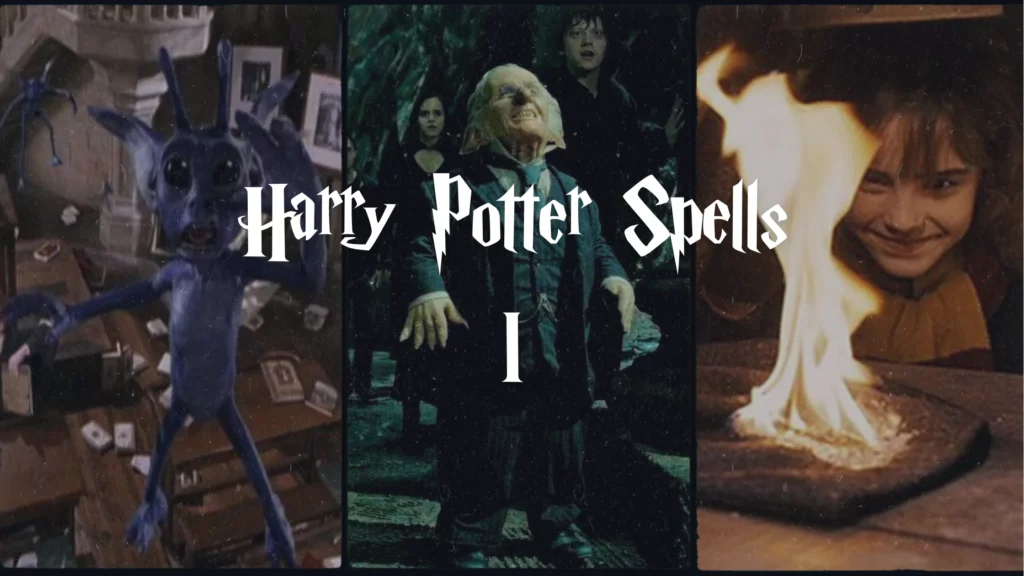
Illegibilus
- Type: Spell
- Effect: Makes text unreadable
- Notable Uses: Used to obscure information.
Illegibilus is a spell that renders text unreadable, making it useful for protecting sensitive information from being deciphered. This spell is often used in academic and security contexts to obscure written material.
Immobulus
- Type: Charm
- Effect: Renders the target immobile
- Notable Uses: Used by Hermione Granger to freeze pixies in “Harry Potter and the Chamber of Secrets.”
Immobulus is a charm that freezes the target in place, rendering them immobile. Hermione Granger uses this spell to stop a swarm of pixies in “Harry Potter and the Chamber of Secrets,” showcasing its utility in controlling chaotic situations.
Impedimenta
- Type: Charm
- Effect: Slows an advancing object
- Notable Uses: Used in duelling and combat scenarios.
Impedimenta is a charm that slows down or stops an advancing object or individual. This spell is frequently used in duelling to impede opponents and gain a tactical advantage.
Imperio
- Type: Curse
- Effect: Controls a person – Unforgivable Curse
- Notable Uses: Used by Death Eaters to manipulate others.
Imperio is one of the Unforgivable Curses, allowing the caster to control the actions of the victim. Death Eaters use this curse to manipulate and command others against their will, demonstrating its dark and unethical nature.
Impervius
- Type: Charm
- Effect: Makes an object repel water
- Notable Uses: Used by Hermione Granger on Harry’s glasses.
Impervius is a charm that makes objects impervious to water, causing liquids to repel off the surface. Hermione Granger uses this spell on Harry’s glasses during a Quidditch match to keep them clear of rain, highlighting its practical applications in adverse weather conditions.
Incarcerous
- Type: Spell
- Effect: Ties someone up
- Notable Uses: Used by Dolores Umbridge to restrain students.
Incarcerous conjures ropes or chains to bind and restrain the target. Dolores Umbridge uses this spell to tie up students who oppose her, demonstrating its use in controlling and subduing individuals.
Incendio
- Type: Spell
- Effect: Starts a fire
- Notable Uses: Used by Hermione Granger to set Snape’s robes on fire during Harry’s first Quidditch match.
Incendio is a spell that conjures flames, making it useful for starting fires. Hermione Granger uses this spell to distract Severus Snape during Harry Potter’s first Quidditch match, demonstrating its utility in both practical and combative situations.
Incendio Duo
- Type: Spell
- Effect: Stronger version of Incendio
- Notable Uses: Seen in various video games.
Incendio Duo is a more powerful version of the Incendio spell, capable of producing larger and more intense flames. This enhanced spell is often used in advanced magical combat scenarios.
Incendio Tria
- Type: Spell
- Effect: Even stronger than Incendio Duo
- Notable Uses: Seen in various video games.
Incendio Tria is the most powerful variant of the Incendio spell, capable of generating massive flames. It is used in high-stakes combat situations, showcasing its destructive capabilities.
Inflatus
- Type: Spell
- Effect: Inflates objects
- Notable Uses: Seen in various video games.
Inflatus is a spell that causes objects or individuals to swell and inflate. This spell is often used for humorous effects and pranks, highlighting the playful side of magic.
Informous
- Type: Spell
- Effect: Gives the caster information on beasts
- Notable Uses: Seen in various video games.
Informous provides the caster with detailed information about magical creatures. This spell is particularly useful for magical researchers and those studying magical zoology, emphasising its educational applications.
L
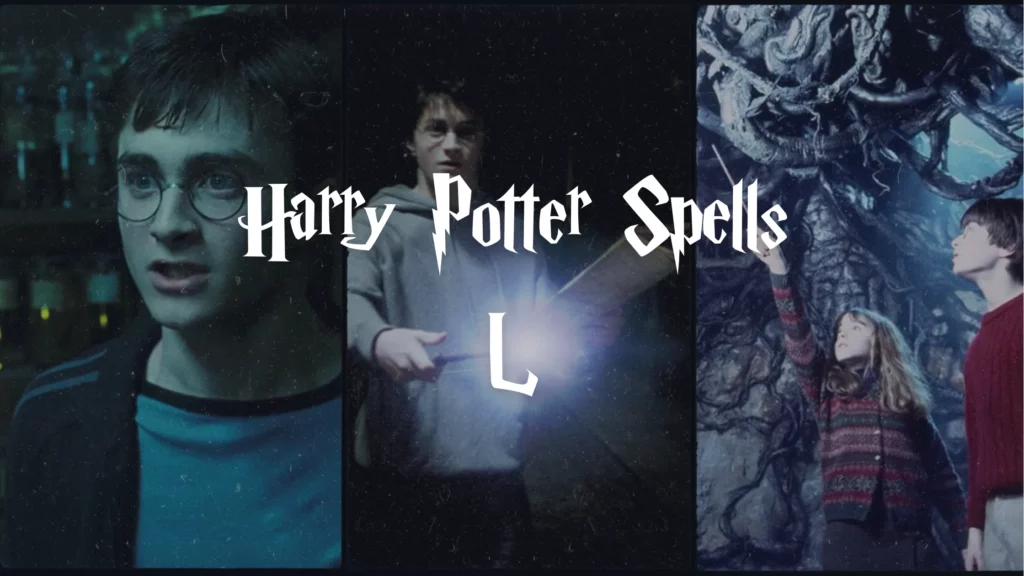
Lacarnum Inflamarae
- Type: Spell
- Effect: Shoots a fireball from the caster’s wand
- Notable Uses: Seen in various video games.
Lacarnum Inflamarae conjures a fireball that can be hurled at targets. This spell is used in both combat and practical applications, demonstrating the offensive potential of fire magic.
Langlock
- Type: Spell
- Effect: Glues the opponent’s tongue to the roof of their mouth
- Notable Uses: Used by Harry Potter on Peeves the Poltergeist.
Langlock is a spell that immobilises the target’s tongue, preventing them from speaking. Harry Potter uses this spell on Peeves the Poltergeist to silence him, showcasing its utility in controlling disruptive individuals.
Lapifors
- Type: Spell
- Effect: Turns the target into a rabbit
- Notable Uses: Seen in various video games.
Lapifors transforms the target into a rabbit. This spell is often used for humorous and whimsical transformations, highlighting the playful aspects of magical transfiguration.
Legilimens
- Type: Spell
- Effect: Allows the caster to read minds
- Notable Uses: Used by Severus Snape to probe Harry Potter’s thoughts.
Legilimens enables the caster to access the thoughts and memories of the target. Severus Snape uses this spell to delve into Harry Potter’s mind during Occlumency lessons, demonstrating its application in interrogation and psychological exploration.
Levicorpus
- Type: Spell
- Effect: Hangs the victim upside down by their ankles
- Notable Uses: Used by James Potter on Severus Snape.
Levicorpus is a jinx that lifts the target into the air by their ankles, leaving them hanging upside down. James Potter famously uses this spell on Severus Snape, showcasing its use in pranks and duelling.
Liberacorpus
- Type: Spell
- Effect: Counterspell to Levicorpus
- Notable Uses: Used by Harry Potter to release Ron Weasley from Levicorpus.
Liberacorpus is the counterspell to Levicorpus, releasing the victim from its effects. Harry Potter uses this spell to free Ron Weasley from an accidental Levicorpus jinx, highlighting its role in undoing magical effects.
Locomotor Mortis
- Type: Curse
- Effect: Locks the target’s legs together
- Notable Uses: Used by Draco Malfoy on Neville Longbottom.
Locomotor Mortis is a jinx that causes the victim’s legs to lock together, making it impossible for them to walk. Draco Malfoy uses this curse on Neville Longbottom, showcasing its use in incapacitating opponents.
Lumos
- Type: Spell
- Effect: Creates light at the wand tip
- Notable Uses: Used frequently by Harry Potter and his friends.
Lumos produces a beam of light from the caster’s wand, illuminating dark areas. This spell is frequently used by Harry Potter and his friends to navigate in the dark, and interestingly, it can also be used to activate the flashlight on iPhones through Siri.
Lumos Duo
- Type: Spell
- Effect: Stronger version of Lumos
- Notable Uses: Seen in various video games.
Lumos Duo is a more powerful version of the Lumos spell, providing a brighter and more focused beam of light. This spell is often used in situations requiring enhanced illumination.
Lumos Maxima
- Type: Spell
- Effect: Creates a ball of light that can brighten a room for an extended period
- Notable Uses: Used by Harry Potter in “Harry Potter and the Prisoner of Azkaban.”
Lumos Maxima generates a large, sustained ball of light that can illuminate an entire room. Harry Potter uses this spell to brighten his surroundings, showcasing its utility in providing long-lasting light.
Lumos Solem
- Type: Spell
- Effect: Creates a strong beam of sunlight
- Notable Uses: Used by Hermione Granger to defeat Devil’s Snare in “Harry Potter and the Sorcerer’s Stone.”
Lumos Solem produces a beam of intense sunlight. Hermione Granger uses this spell to defeat the Devil’s Snare plant, demonstrating its effectiveness against dark and light-sensitive creatures.
M
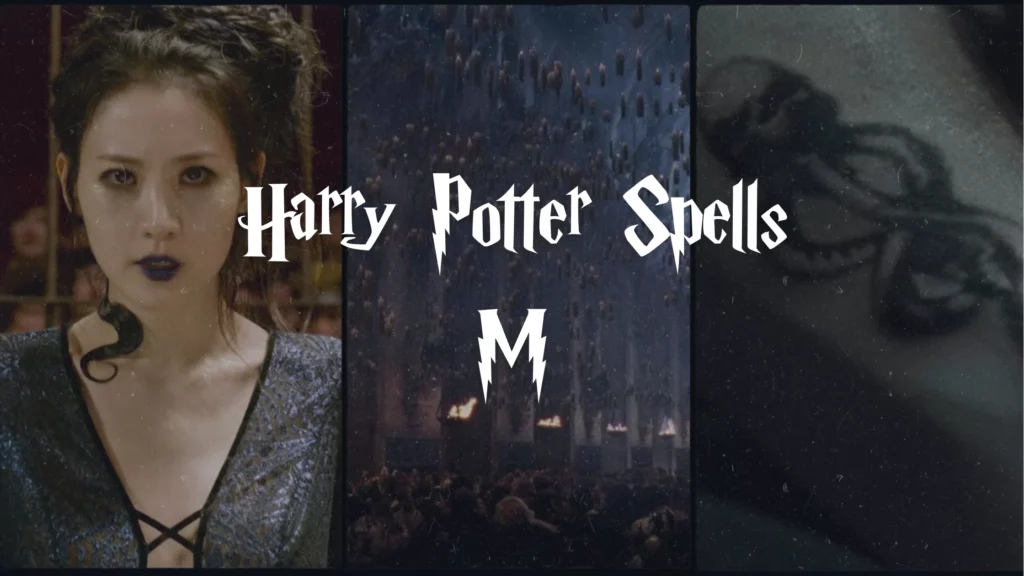
Maledictus
- Type: Curse
- Effect: Causes the victim to transform into a snake permanently
- Notable Uses: Mentioned in “Fantastic Beasts.”
The Maledictus curse causes the victim to transform into a snake permanently. This dark and irreversible curse highlights the transformative and often tragic nature of certain magical afflictions.
Magicus Extremos
- Type: Spell
- Effect: Enhances the power of spells
- Notable Uses: Seen in various video games.
Magicus Extremos amplifies the potency of the caster’s spells, making them more powerful. This spell is often used in combat to boost magical attacks, demonstrating its utility in enhancing magical abilities.
Melofors
- Type: Jinx
- Effect: Gives someone a pumpkin head
- Notable Uses: Seen in various video games.
Melofors is a jinx that causes the victim’s head to transform into a pumpkin. This spell is often used for humorous effects and pranks, highlighting the whimsical side of magical jinxes.
Meteolojinx Recanto
- Type: Spell
- Effect: Causes weather effects to stop
- Notable Uses: Used by Ministry of Magic employees to control magical weather phenomena.
Meteolojinx Recanto halts the effects of weather-related spells. This spell is used by Ministry of Magic employees to control and manage magical weather phenomena, demonstrating its importance in maintaining magical order and safety.
Mimblewimble
- Type: Curse
- Effect: Tongue-ties its victim
- Notable Uses: Used to prevent someone from speaking coherently.
Mimblewimble, also known as the Tongue-Tying Curse, prevents the victim from speaking clearly, rendering them unable to cast spells verbally. This curse is useful for silencing opponents in duelling situations.
Mobiliarbus
- Type: Charm
- Effect: Moves objects with the wand
- Notable Uses: Used by Hermione Granger to move Christmas trees in “Harry Potter and the Prisoner of Azkaban.”
Mobiliarbus is a charm that levitates and moves objects. Hermione Granger uses this spell to move Christmas trees at the Leaky Cauldron, demonstrating its practical use in arranging and relocating items.
Mobilicorpus
- Type: Spell
- Effect: Moves unconscious bodies
- Notable Uses: Used by Remus Lupin to move an unconscious Snape.
Mobilicorpus allows the caster to levitate and move unconscious individuals. Remus Lupin uses this spell to transport an unconscious Severus Snape during an altercation, showcasing its utility in medical emergencies and rescue situations.
Morsmordre
- Type: Spell
- Effect: Conjures the Dark Mark
- Notable Uses: Used by Death Eaters to summon the Dark Mark in the sky.
Morsmordre is a dark spell that conjures the Dark Mark, the symbol of Voldemort and his followers. This spell is used by Death Eaters to mark their presence after attacks, spreading fear and intimidation.
Muffliato
- Type: Spell
- Effect: Prevents nearby people from overhearing conversations
- Notable Uses: Frequently used by Harry Potter and his friends for private conversations.
Muffliato creates a buzzing sound in the ears of anyone nearby, preventing them from eavesdropping on conversations. This spell is often used by Harry Potter and his friends to discuss sensitive matters in private.
Multicorfors
- Type: Spell
- Effect: Changes the colours of objects
- Notable Uses: Seen in various video games.
Multicorfors changes the colour of objects, allowing for decorative and aesthetic alterations. This spell is commonly used for fun and creative purposes, highlighting the whimsical aspects of magic.
N
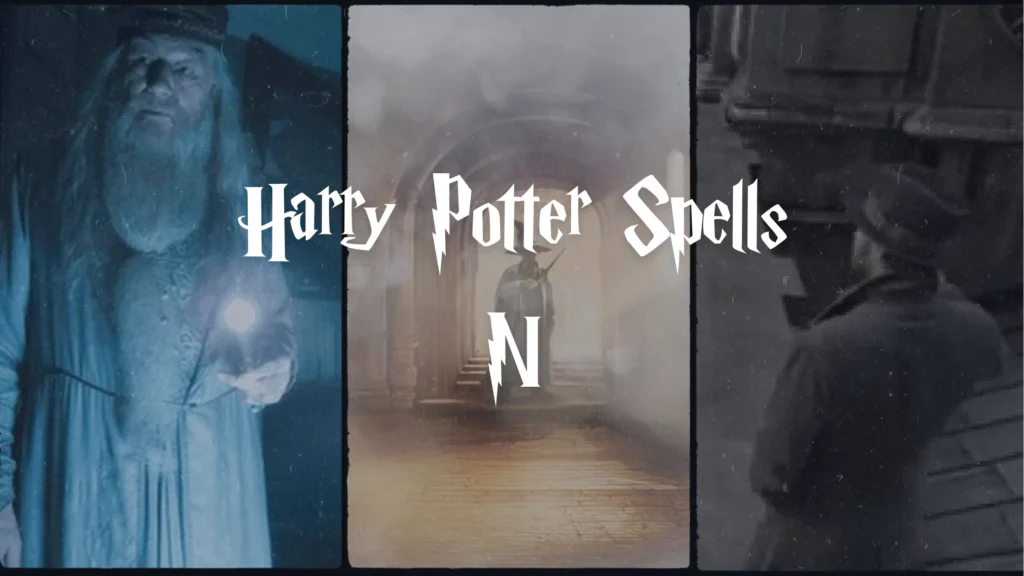
Nebulus
- Type: Spell
- Effect: Creates dense fog
- Notable Uses: Used to obscure visibility.
Nebulus conjures a thick fog that obscures vision, making it useful for creating cover or confusion. This spell is often employed in escape scenarios or to protect against prying eyes.
Nox
- Type: Spell
- Effect: Extinguishes light from the wand
- Notable Uses: Counterspell to Lumos.
Nox is the counterspell to Lumos, extinguishing the light produced by the wand. This spell is frequently used to return to darkness after illuminating an area, and it can also be used to turn off the flashlight on iPhones through Siri.
O
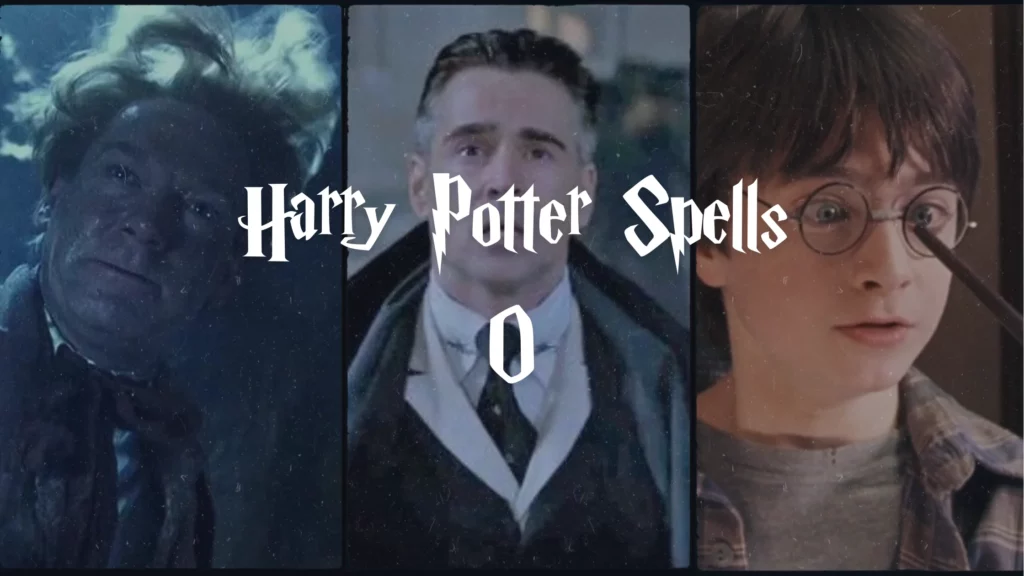
Oculus Reparo
- Type: Spell
- Effect: Repairs eyeglasses
- Notable Uses: Used by Hermione Granger to fix Harry Potter’s glasses.
Oculus Reparo is a simple yet useful spell that repairs broken eyeglasses. Hermione Granger uses this spell to fix Harry Potter’s glasses on several occasions, showcasing its practical application in everyday life.
Obliteration Charm
- Type: Charm
- Effect: Removes traces, such as footprints
- Notable Uses: Used to cover tracks and obscure evidence.
The Obliteration Charm removes physical traces like footprints, making it useful for covering one’s tracks. This charm is often used to ensure stealth and maintain secrecy.
Obliviate
- Type: Charm
- Effect: Erases memories
- Notable Uses: Used by Gilderoy Lockhart and Hermione Granger.
Obliviate erases specific memories from the target’s mind. Gilderoy Lockhart uses this spell frequently, often with disastrous results, and Hermione Granger uses it to protect her parents from the dangers of the wizarding world.
Obscuro
- Type: Spell
- Effect: Blindfolds the victim
- Notable Uses: Used to prevent someone from seeing.
Obscuro creates a blindfold over the target’s eyes, rendering them unable to see. This spell is useful for incapacitating opponents or protecting sensitive information from being observed.
Oppugno
- Type: Spell
- Effect: Makes conjured items attack
- Notable Uses: Used by Hermione Granger to attack Ron Weasley with conjured birds.
Oppugno directs conjured creatures or objects to attack a target. Hermione Granger uses this spell to send a flock of conjured birds after Ron Weasley in a fit of anger, demonstrating its use in directing magical attacks.
Orbis
- Type: Jinx
- Effect: Sticks the target into the ground
- Notable Uses: Seen in various video games.
Orbis is a jinx that causes the target to be stuck in the ground, immobilising them. This spell is often used in duelling scenarios to trap opponents and limit their movements.
Orchideous
- Type: Spell
- Effect: Conjures a bunch of flowers
- Notable Uses: Used to produce flowers for decorative purposes.
Orchideous conjures a bouquet of flowers from the caster’s wand. This spell is often used for decorative and romantic purposes, showcasing the whimsical side of magic.
P
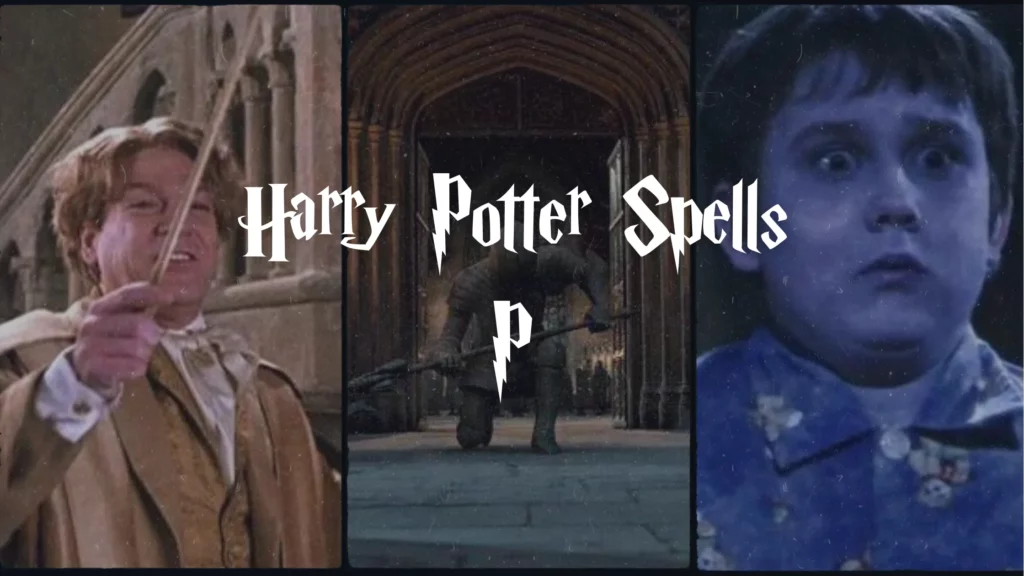
Pack
- Type: Spell
- Effect: Packs a trunk (suitcase)
- Notable Uses: Used to efficiently pack luggage.
Pack is a spell that organises and packs items into a trunk or suitcase. This spell is particularly useful for travelling witches and wizards, making the packing process quick and efficient.
Partis Temporus
- Type: Spell
- Effect: Causes a gap in charmed barriers
- Notable Uses: Used to create openings in protective enchantments.
Partis Temporus creates a temporary gap in magical barriers or protections, allowing passage through them. This spell is useful for navigating through enchanted defences.
Periculum
- Type: Spell
- Effect: Creates fireworks from the wand tip
- Notable Uses: Used to signal for help or celebration.
Periculum shoots red sparks from the caster’s wand, creating a signal flare. This spell is often used to call for help or to celebrate, highlighting its versatility in both emergency and festive situations.
Permanent Sticking Charm
- Type: Charm
- Effect: Causes items to permanently stick to things
- Notable Uses: Used by Sirius Black to permanently affix posters and decorations.
The Permanent Sticking Charm ensures that items affixed with it cannot be removed. Sirius Black uses this charm to stick posters and decorations permanently to the walls of his room at Grimmauld Place.
Peskipiksi Pesternomi
- Type: Spell
- Effect: Intended to remove pixies (effectiveness is questionable)
- Notable Uses: Infamously used by Gilderoy Lockhart.
Peskipiksi Pesternomi is intended to remove pixies, but its effectiveness is dubious. Gilderoy Lockhart uses this spell to disastrous effect when attempting to remove Cornish Pixies, showcasing his incompetence.
Petrificus Totalus
- Type: Spell
- Effect: Body-Bind Curse
- Notable Uses: Used by Hermione Granger on Neville Longbottom in “Harry Potter and the Sorcerer’s Stone.”
Petrificus Totalus, also known as the Full Body-Bind Curse, renders the victim completely immobile. Hermione Granger uses this spell on Neville Longbottom to prevent him from interfering with their plan to stop Voldemort from obtaining the Sorcerer’s Stone.
Piertotum Locomotor
- Type: Spell
- Effect: Animates statues and armour suits
- Notable Uses: Used by Professor McGonagall during the Battle of Hogwarts.
Piertotum Locomotor brings inanimate objects, such as statues and suits of armour, to life. Professor McGonagall uses this spell to animate the statues of Hogwarts to defend the school during the Battle of Hogwarts, showcasing its utility in combat situations.
Point Me
- Type: Charm
- Effect: Wand acts like a compass
- Notable Uses: Used by Harry Potter during the Triwizard Tournament.
The Four-Point Spell, or Point Me, causes the caster’s wand to point north, acting as a compass. Harry Potter uses this spell during the Triwizard Tournament to navigate through the maze in the final task, demonstrating its practical use in navigation.
Portus
- Type: Charm
- Effect: Makes an object a Portkey for travelling
- Notable Uses: Used by Dumbledore to transport members of the Order of the Phoenix.
Portus turns an object into a Portkey, which can transport anyone touching it to a predetermined location. Dumbledore uses this spell to create Portkeys for members of the Order of the Phoenix, highlighting its importance in magical transportation.
Priori Incantatem
- Type: Spell
- Effect: Reveals the last spell cast by a wand
- Notable Uses: Occurs during Harry Potter’s duel with Voldemort in “Harry Potter and the Goblet of Fire.”
Priori Incantatem reveals the most recent spells cast by a wand, often resulting in ghostly echoes of the victims of those spells. This effect occurs during the duel between Harry Potter and Voldemort, providing a dramatic confrontation and revealing the past victims of Voldemort’s wand.
Prior Incantato
- Type: Spell
- Effect: Shows a wand’s last spell
- Notable Uses: Used by Amos Diggory on Harry Potter’s wand in “Harry Potter and the Goblet of Fire.”
Prior Incantato is a spell that shows the last spell a wand has cast. Amos Diggory uses it on Harry Potter’s wand to reveal that it cast the Dark Mark, demonstrating its use in forensic magic and investigations.
Protego
- Type: Charm
- Effect: Reflects spells back to the sender
- Notable Uses: Frequently used by Harry Potter in duels.
Protego, also known as the Shield Charm, creates a magical barrier that reflects spells back to the sender. Harry Potter frequently uses this charm in duels to protect himself from attacks, showcasing its defensive capabilities.
Protego Diabolica
- Type: Charm
- Effect: Creates black fire – Protective fire
- Notable Uses: Used by Grindelwald in “Fantastic Beasts: The Crimes of Grindelwald.”
Protego Diabolica conjures a ring of black fire that only allows the caster’s allies to pass through unharmed. Grindelwald uses this spell to test the loyalty of his followers, demonstrating its dark and dangerous nature.
Protego Horribilis
- Type: Charm
- Effect: Protects against dark magic
- Notable Uses: Used to defend against powerful dark spells.
Protego Horribilis is a strong protective charm designed to shield against dark magic. This spell is often used to defend against powerful curses and dark spells, highlighting its importance in combating dark forces.
Protego Maxima
- Type: Charm
- Effect: More powerful version of Protego Horribilis
- Notable Uses: Used by Hogwarts staff to protect the castle during the Battle of Hogwarts.
Protego Maxima is an enhanced version of the Protego charm, providing an even stronger barrier against dark magic. The staff of Hogwarts uses this spell to protect the castle during the Battle of Hogwarts, demonstrating its critical role in large-scale defences.
Protego Totalum
- Type: Charm
- Effect: Area protection spell
- Notable Uses: Used by Hermione Granger to protect their campsite.
Protego Totalum creates a protective shield over a large area. Hermione Granger uses this spell to protect their campsite from detection and attack, showcasing its utility in ensuring safety over a significant area.
Q
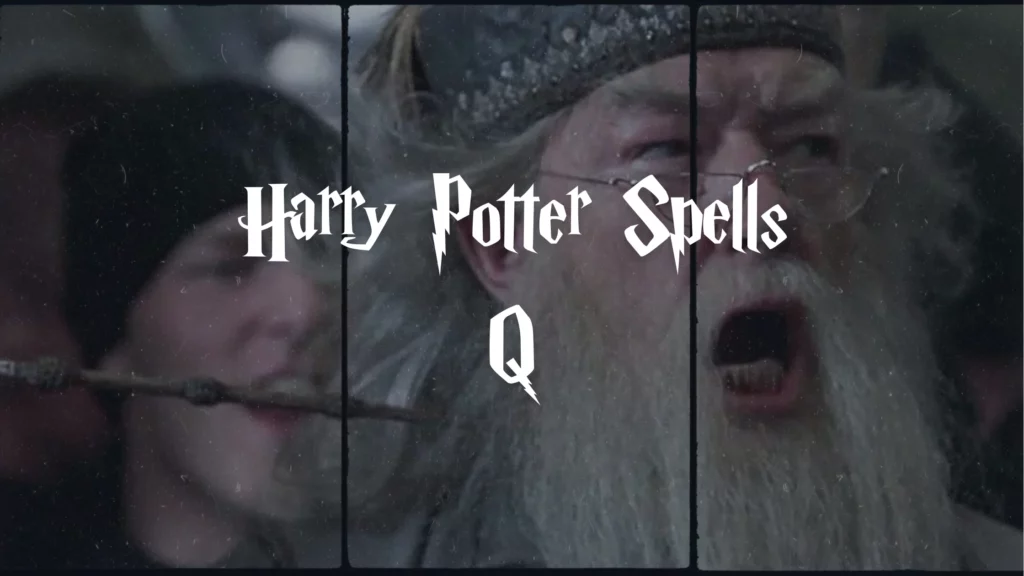
Quietus
- Type: Spell
- Effect: Counter spell for Sonorus
- Notable Uses: Used to reduce the volume of magically amplified sound.
Quietus is the counter spell to Sonorus, reducing the volume of amplified sound back to normal. This spell is often used to control the loudness of magically enhanced voices or noises.
R
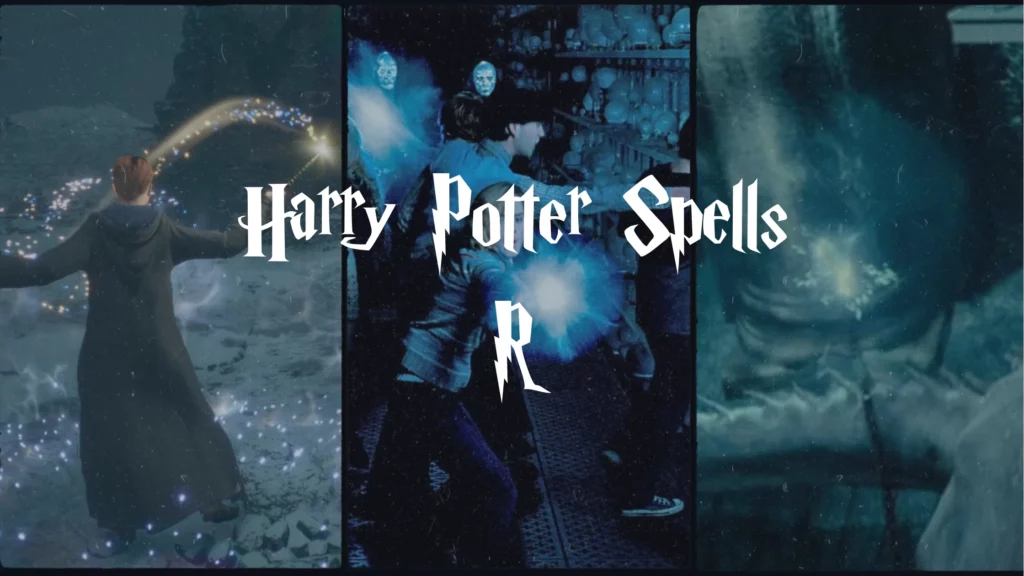
Redactum Skullus
- Type: Hex
- Effect: Shrinks heads
- Notable Uses: Seen in various video games.
Redactum Skullus is a hex that causes the target’s head to shrink. This spell is often used for humorous or intimidating effects, highlighting the mischievous nature of hexes.
Reducio
- Type: Spell
- Effect: Returns items to original size; counters Engorgio
- Notable Uses: Used to shrink enlarged objects or creatures.
Reducio is a spell that reduces the size of an enlarged object or creature, countering the effects of the Engorgio spell. This spell is essential for restoring items to their normal size after they have been magically enlarged.
Reducto
- Type: Spell
- Effect: Blasts solid objects aside
- Notable Uses: Used by Harry Potter to clear obstacles during the Triwizard Tournament.
Reducto, also known as the Reductor Curse, blasts solid objects out of the caster’s path. Harry Potter uses this spell during the Triwizard Tournament to clear obstacles, demonstrating its utility in creating clear pathways.
Relashio
- Type: Spell
- Effect: Releases the user from binding
- Notable Uses: Used by Harry Potter to free himself from Grindylows.
Relashio is a spell that releases the caster from physical restraints or bindings. Harry Potter uses this spell to free himself from Grindylows during the second task of the Triwizard Tournament, showcasing its importance in escaping captivity.
Rennervate
- Type: Spell
- Effect: Revives unconscious individuals
- Notable Uses: Used by Harry Potter to revive a stunned Hermione Granger.
Rennervate is a spell that revives individuals who have been stunned or rendered unconscious. Harry Potter uses this spell to wake up Hermione Granger after she is knocked out during a battle, highlighting its crucial role in medical emergencies.
Reparo
- Type: Spell
- Effect: Repairs broken objects
- Notable Uses: Used frequently by Hermione Granger.
Reparo is a spell that mends broken objects, returning them to their original state. Hermione Granger frequently uses this spell to fix various items, demonstrating its practical applications in everyday life.
Repello Muggletum
- Type: Charm
- Effect: Keeps Muggles away
- Notable Uses: Used to protect magical areas from Muggle intrusion.
Repello Muggletum creates a magical barrier that repels Muggles, preventing them from entering magical areas. This charm is often used to protect wizarding locations from being discovered by non-magical people.
Repello Inimicum
- Type: Charm
- Effect: Keeps evil beings away; wide area protection
- Notable Uses: Used by Hermione Granger to protect their campsite.
Repello Inimicum creates a protective barrier that repels dark forces and evil beings. Hermione Granger uses this charm to safeguard their campsite, highlighting its importance in providing extensive protection against threats.
Revelio
- Type: Spell
- Effect: Reveals hidden objects or secrets
- Notable Uses: Used by Newt Scamander to reveal hidden spells in “Fantastic Beasts.” This was also a prominent spell in the game “Hogwarts Legacy”.
Revelio is a spell that uncovers hidden objects or secrets. Newt Scamander uses this spell to reveal hidden spells and objects, demonstrating its importance in uncovering concealed items and truths.
Rictusempra
- Type: Charm
- Effect: Tickles the opponent
- Notable Uses: Used by Harry Potter on Draco Malfoy during a duelling club session.
Rictusempra, also known as the Tickling Charm, causes the target to laugh uncontrollably due to a tickling sensation. Harry Potter uses this spell on Draco Malfoy during a duelling club session, highlighting its use in playful and non-lethal combat.
Riddikulus
- Type: Spell
- Effect: Transforms a boggart into something humorous
- Notable Uses: Used by various characters in “Harry Potter and the Prisoner of Azkaban.”
Riddikulus is used to defeat a boggart by transforming it into something humorous, rendering it harmless. This spell is taught to students at Hogwarts as a way to face and overcome their fears.
S
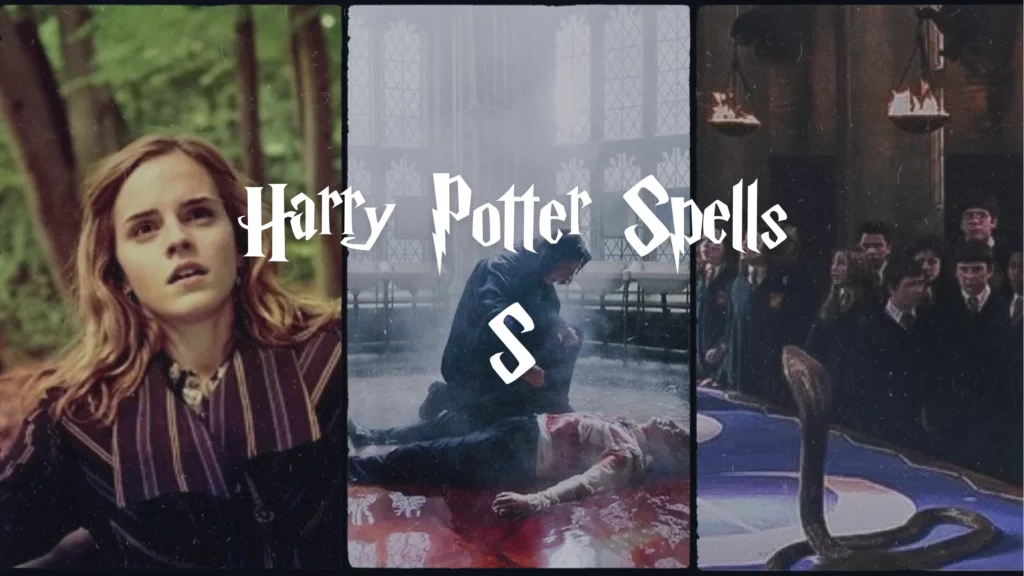
Salvio Hexia
- Type: Spell
- Effect: Protection against hexes
- Notable Uses: Used by Hermione Granger to protect their campsite.
Salvio Hexia is a protective spell that guards against hexes. Hermione Granger uses this spell to safeguard their campsite from dark magic and enemies, showcasing its importance in maintaining security.
Scourgify
- Type: Charm
- Effect: A cleaning charm
- Notable Uses: Used by various characters to clean objects and surfaces.
Scourgify is a charm that cleans objects and surfaces. This spell is commonly used by witches and wizards to maintain cleanliness and hygiene, highlighting its practical applications in daily life.
Scurge
- Type: Charm
- Effect: Destroys the remains of ghosts
- Notable Uses: Seen in various video games.
Scurge is a charm that destroys ectoplasmic residue left by ghosts. This spell is useful for dealing with supernatural messes and maintaining a clean environment.
Sectumsempra
- Type: Spell
- Effect: Causes deep cuts, as if slashed by a sword
- Notable Uses: Used by Harry Potter on Draco Malfoy.
Sectumsempra is a dark spell that causes deep, bleeding cuts on the victim. Harry Potter uses this spell on Draco Malfoy, resulting in severe injury, showcasing the spell’s lethal and dangerous nature.
Serpensortia
- Type: Spell
- Effect: Produces a snake
- Notable Uses: Used by Draco Malfoy during a duelling club session.
Serpensortia conjures a snake from the caster’s wand. Draco Malfoy uses this spell during a duelling club session to intimidate and attack, highlighting its use in magical duels.
Silencio
- Type: Spell
- Effect: Silences the victim
- Notable Uses: Used by Hermione Granger on a rogue Bludger.
Silencio is a spell that renders the target silent, preventing them from making any noise. Hermione Granger uses this spell to silence a rogue Bludger, demonstrating its utility in controlling loud and disruptive objects or individuals.
Slugulus Eructo
- Type: Charm
- Effect: Makes the victim vomit slugs
- Notable Uses: Used by Ron Weasley on Draco Malfoy, but backfires.
Slugulus Eructo causes the victim to vomit slugs. Ron Weasley attempts to use this spell on Draco Malfoy, but it backfires and affects Ron instead, highlighting the humorous and sometimes unpredictable nature of magic.
Sonorus
- Type: Spell
- Effect: Amplifies the caster’s voice
- Notable Uses: Used by various characters to make announcements.
Sonorus amplifies the caster’s voice, making it loud enough to be heard over a large area. This spell is often used for public announcements and in large gatherings to ensure everyone can hear the speaker.
Specialis Revelio
- Type: Spell
- Effect: Reveals hidden secrets or magical properties
- Notable Uses: Used by Hermione Granger to identify potions and magical objects.
Specialis Revelio is a spell that uncovers hidden secrets or magical properties of objects. Hermione Granger uses this spell to identify the nature of various potions and magical items, showcasing its importance in magical investigation and research.
Spongify
- Type: Charm
- Effect: Softens things
- Notable Uses: Seen in various video games.
Spongify is a charm that makes objects soft and bouncy, similar to a sponge. This spell is often used to create safe landing areas and in duelling scenarios to cushion impacts.
Steleus
- Type: Hex
- Effect: Makes the victim sneeze for a period
- Notable Uses: Seen in various video games.
Steleus causes the victim to sneeze uncontrollably. This hex is used to incapacitate opponents temporarily, providing a distraction or an advantage in duelling situations.
Stinging Jinx
- Type: Jinx
- Effect: Makes the victim feel stinging and get a rash
- Notable Uses: Used by various characters in combat situations.
The Stinging Jinx causes a painful stinging sensation and a rash on the victim. This jinx is often used in duelling to cause discomfort and distract the opponent.
Stupefy
- Type: Spell
- Effect: Knocks out the opponent
- Notable Uses: Frequently used by Harry Potter and other characters in battles.
Stupefy, also known as the Stunning Spell, knocks the target unconscious. This spell is a staple in magical combat, frequently used by Harry Potter and other characters to incapacitate opponents without causing permanent harm.
Surgito
- Type: Spell
- Effect: Removes a love enchantment from someone
- Notable Uses: Mentioned in the series.
Surgito is a spell that removes love enchantments and other magical compulsions from the target. This spell is essential for breaking charms and hexes that affect a person’s emotions or behaviour.
Switching Spell
- Type: Spell
- Effect: Switches objects
- Notable Uses: Taught in Transfiguration classes at Hogwarts.
The Switching Spell swaps the positions of two objects. This spell is taught in Transfiguration classes at Hogwarts and is useful for a variety of practical and combat applications.
T
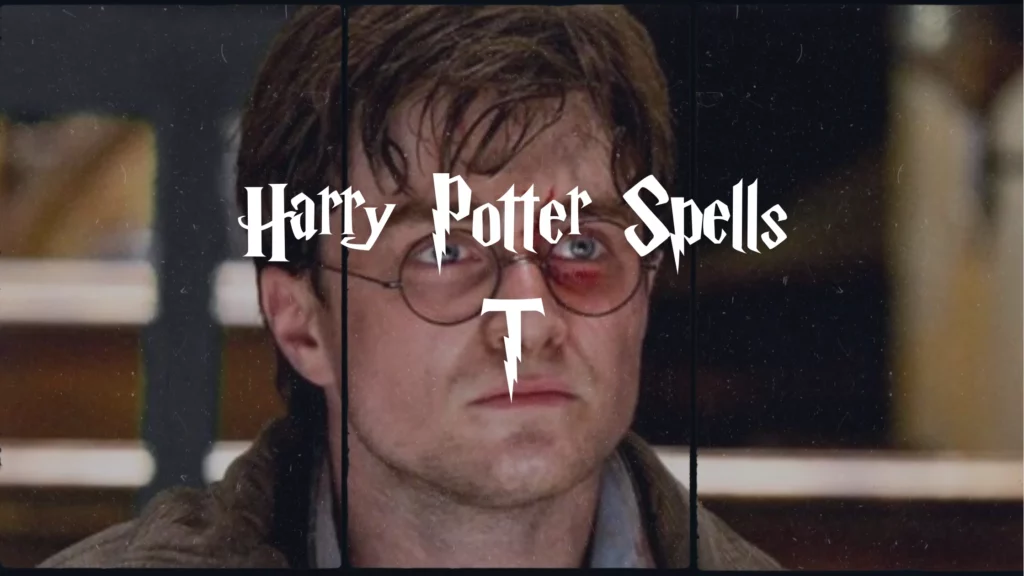
Tarantallegra
- Type: Spell
- Effect: Forces the opponent to dance uncontrollably
- Notable Uses: Used by Draco Malfoy on Harry Potter.
Tarantallegra causes the victim’s legs to move uncontrollably in a dancing motion. Draco Malfoy uses this spell on Harry Potter during a duel, demonstrating its use in distracting and incapacitating opponents.
Tentaclifors
- Type: Jinx
- Effect: Gives the victim a tentacle head
- Notable Uses: Seen in various video games.
Tentaclifors transforms the victim’s head into a tentacle. This jinx is often used for humorous or intimidating effects, highlighting the creative and sometimes bizarre nature of magical transformations.
Tergeo
- Type: Spell
- Effect: Cleans up messes
- Notable Uses: Used by Hermione Granger to clean blood off Harry’s face.
Tergeo is a cleaning spell that syphons off liquid and removes messes. Hermione Granger uses this spell to clean blood from Harry Potter’s face, showcasing its practical applications in maintaining cleanliness and hygiene.
Titillando
- Type: Hex
- Effect: Tickles the target and weakens them
- Notable Uses: Seen in various card games.
Titillando is a hex that causes the target to laugh uncontrollably due to a tickling sensation, weakening them. This spell is often used to incapacitate opponents by rendering them helpless with laughter.
Transmogrify
- Type: Spell
- Effect: Deforms the body of the target
- Notable Uses: Seen in various card games.
Transmogrify is a spell that deforms the target’s body, causing physical changes that can be disorienting or harmful. This spell highlights the transformative and sometimes sinister side of magic.
U
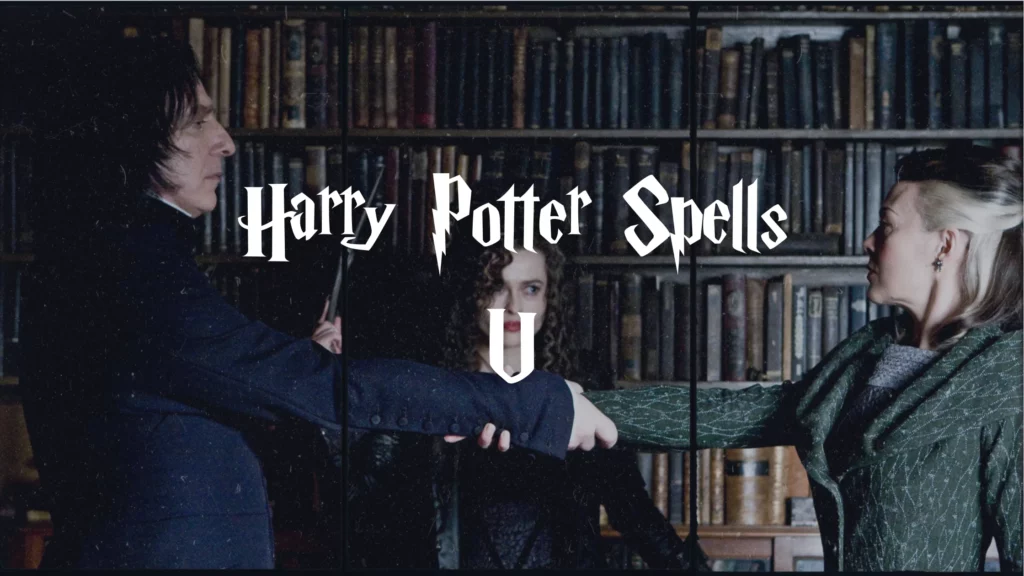
Unbreakable Vow
- Type: Spell
- Effect: If you break the vow you make, you die
- Notable Uses: Used by Severus Snape and Narcissa Malfoy.
The Unbreakable Vow is a binding magical contract that results in the death of the vow-maker if they break their promise. Severus Snape makes an Unbreakable Vow with Narcissa Malfoy to protect Draco Malfoy, showcasing the serious and life-threatening consequences of this spell.
V
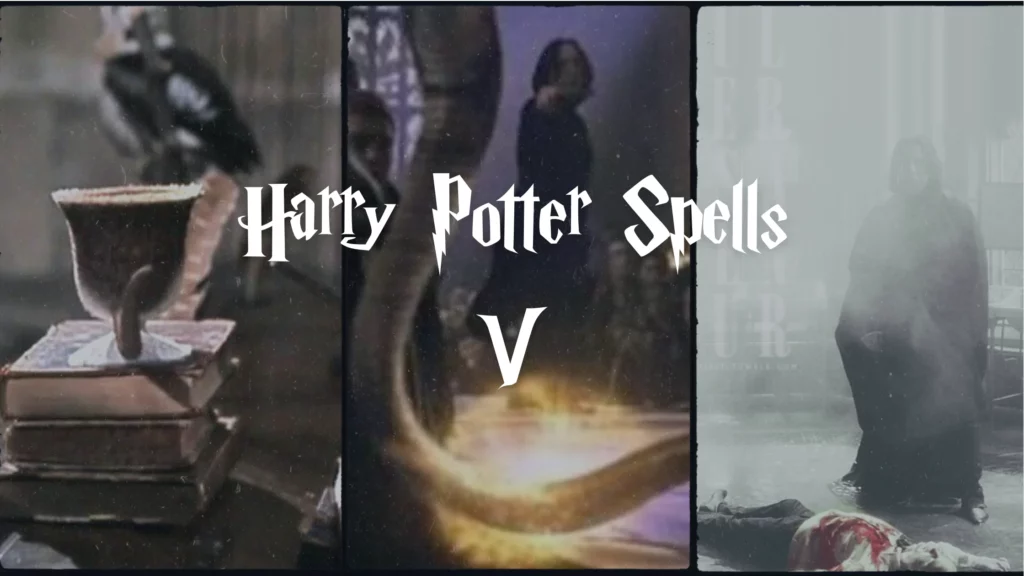
Ventus
- Type: Spell
- Effect: Shoots a gust of hurricane-force wind from the wand
- Notable Uses: Seen in various video games.
Ventus is a spell that produces a powerful gust of wind from the caster’s wand. This spell is useful for blowing objects away or creating barriers of wind, demonstrating its utility in both combat and environmental manipulation.
Ventus Duo
- Type: Spell
- Effect: Stronger version of Ventus
- Notable Uses: Seen in various video games.
Ventus Duo is a more powerful version of the Ventus spell, capable of producing even stronger gusts of wind. This enhanced spell is often used in advanced magical combat scenarios.
Vera Verto
- Type: Spell
- Effect: Turns animals into water goblets
- Notable Uses: Taught in Transfiguration classes at Hogwarts.
Vera Verto is a spell that transforms animals into water goblets. This spell is taught in Transfiguration classes at Hogwarts and showcases the ability to change the form and function of living creatures.
Verdimillious
- Type: Spell
- Effect: Reveals objects and damages foes
- Notable Uses: Seen in various video games.
Verdimillious is a spell that produces green sparks to reveal hidden objects and damage opponents. This spell is useful in both exploration and combat, highlighting its versatility.
Verdimillious Duo
- Type: Spell
- Effect: More powerful version of Verdimillious
- Notable Uses: Seen in various video games.
Verdimillious Duo is a stronger variant of Verdimillious, capable of producing more intense green sparks for revealing hidden objects and dealing greater damage to foes.
Vipera Evanesca
- Type: Spell
- Effect: Makes snakes vanish
- Notable Uses: Used by Professor Snape to vanish the snake conjured by Draco Malfoy.
Vipera Evanesca is a spell that causes snakes to disappear. Professor Snape uses this spell to make the snake conjured by Draco Malfoy vanish during a duelling club session, showcasing its utility in removing conjured creatures.
Vulnera Sanentur
- Type: Spell
- Effect: Heals wounds
- Notable Uses: Used by Severus Snape to heal Draco Malfoy.
Vulnera Sanentur is a healing spell that mends wounds and stops bleeding. Severus Snape uses this spell to heal Draco Malfoy’s injuries caused by Sectumsempra, demonstrating its importance in medical magic.
W
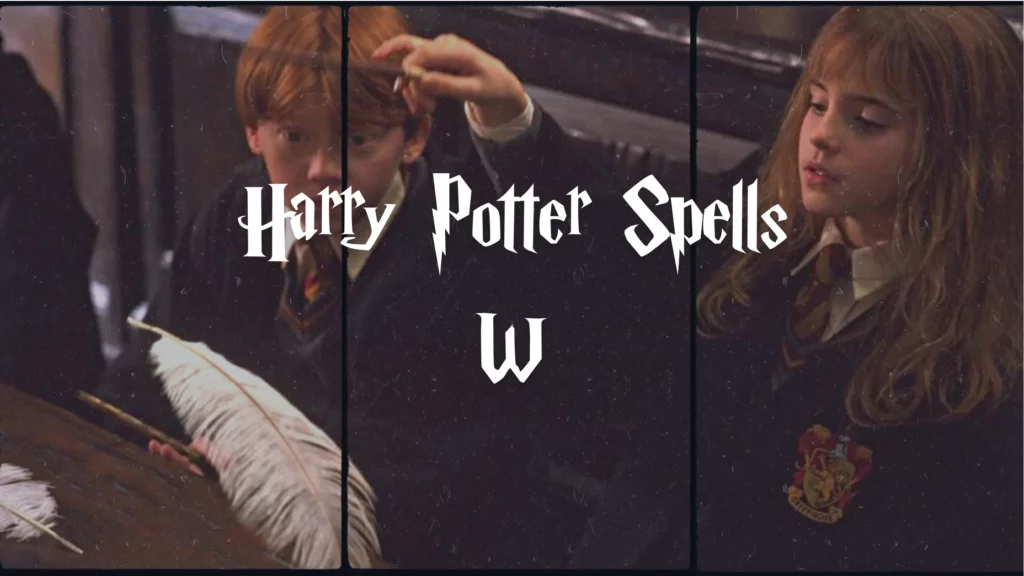
Waddiwasi
- Type: Spell
- Effect: Unsticks an object
- Notable Uses: Used by Remus Lupin to unstick a wad of gum.
Waddiwasi is a spell that unsticks objects and propels them at high speed. Remus Lupin uses this spell to remove a wad of gum from a keyhole and shoot it at Peeves the Poltergeist, showcasing its practical and humorous applications.
Wingardium Leviosa
- Type: Charm
- Effect: Makes objects fly
- Notable Uses: Taught to first-year students at Hogwarts.
Wingardium Leviosa is a levitation charm that allows the caster to make objects float and move through the air. This spell is famously taught to first-year students at Hogwarts and is one of the most iconic spells in the wizarding world.
Advanced Spellcasting Techniques
Non-verbal Magic: Explanation and Examples
Non-verbal magic is an advanced technique where a witch or wizard casts spells without speaking the incantation aloud. This method requires a high level of concentration and control, as the caster must focus their magical intent internally. Non-verbal magic is particularly useful in duels and situations where silence is necessary.
Examples of non-verbal magic include Professor Snape’s ability to cast complex spells without uttering a word, showcasing his mastery over this technique. Non-verbal magic is taught to advanced students at Hogwarts, emphasising the importance of mental discipline and the deep understanding of magical principles.
Wandless Magic: Discussion of Its Difficulty and Use
Wandless magic is an even more challenging form of spellcasting that does not rely on a wand to channel magical energy. While all witches and wizards possess an innate magical ability, most require a wand to focus and control their power. Wandless magic demands exceptional skill, innate talent, and intense training.
Few wizards can perform wandless magic proficiently. Albus Dumbledore and Lord Voldemort are among the rare individuals capable of such feats, demonstrating their extraordinary magical prowess. Wandless magic is often used for simple spells or in moments of extreme necessity, highlighting its role as a testament to a wizard’s true magical potential.
Everyday Magic
In the wizarding world, magic is seamlessly integrated into daily life, making mundane tasks easier and more efficient. Household spells like “Scourgify” for cleaning and “Aguamenti” for summoning water are commonly used. The “Summoning Charm” (Accio) is particularly handy for retrieving objects without physical effort.
Magical transportation methods, such as Apparition and Portkeys, facilitate quick travel over long distances, while spells like “Lumos” and “Nox” provide convenient sources of light. Healing spells, such as “Episkey” and “Ferula,” are essential for treating injuries. These practical applications of magic illustrate how deeply ingrained and versatile spellcasting is in the daily lives of witches and wizards.
Frequently Asked Questions (FAQs)
What is the most powerful spell in Harry Potter?
“Avada Kedavra” is considered the most powerful spell due to its lethal effect. Other spells like “Expecto Patronum” are also incredibly powerful within their specific uses, such as defending against Dementors.
Can Muggles use magic?
Muggles cannot use magic as they lack the necessary magical ability. They might witness magical phenomena or use enchanted objects without understanding the magic behind them.
Why do wizards need wands?
Wands are essential for channelling and focusing a wizard’s magical power. They provide precision and control, making spells more effective and manageable, especially for complex magic.
Are all spells in Latin?
No, not all spells are in Latin. While many spells use Latin or Latin-like words, others are derived from different languages or are unique creations. The diversity in spell language reflects the rich cultural history of the magical world.




